Industry
- Details
- Written by: Quintus Potgieter
In this time of global market uncertainty, the one thing that we know for sure is that the world needs energy. It’s not only essential to our daily lives but needed in increasingly larger quantities to support economic and social progress, build a better quality of life, and support a sustainable future.
However, for developing countries, the need for reliable and affordable energy is more fundamental. Reliable energy supply can help improve industry, agriculture, trade, and transportation. These are the crucial building blocks that help people escape poverty and create better lives and communities.
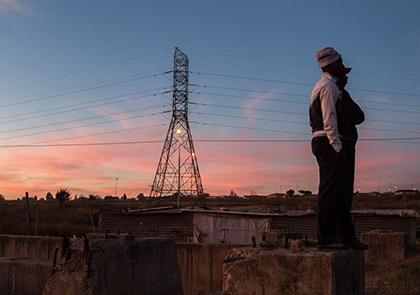
Since 2007, South Africa has experienced widespread rolling blackouts as energy supply consistently falls behind demand. The country’s primary power generator, Eskom, began load shedding in an attempt to prevent the country’s entire power grid from collapsing. This hastily implemented plan has affected energy reliability in South Africa to this day could possibly remain for at least the next “five to seven years.”
Power outages can result in substantial financial losses, quality issues, occupational safety hazards, and time delays that could lead to lost business. As a result of this, many South African consumers quickly invested in diesel-powered commercial standby generators to keep their operations running.
However, the unprecedented 2020 coronavirus lockdown regulations and the sudden increase in the number of people staying at home meant generator manufacturers and installers experienced a significant slow-down in demand. According to sources, some engineers in commercial standby generator installation companies had their wages cut by 30 percent during the lockdown.
As restrictions begin to ease and people begin to return to work, the sector is slowly starting to recover. However, some companies are still opting to let a large portion of employees work from home. This has produced an increased demand for more residential solutions, such as battery-based backup systems.
While generators are a quick short-term solution, battery-based systems are much more effective for long term regular power failures. As they are quick and easy to implement and much quieter to operate, there are several benefits over standard generator systems.
University of Western Cape’s Energy Storage Innovation Lab (ESIL) has been researching how they can improve battery performance to become a viable method of combatting the effects of blackouts. They believe utilizing battery-based backup systems will contribute to GPD growth through meaningful job creation and make use of South Africa’s mineral deposits and mining industry.
“It’s only a matter of time: future batteries and supercapacitors are going to change the world,” says Head of ESIL, Professor Bernard Bladergroen.
“Renewable energy combined with an energy storage device such as a battery that could deliver electricity at the cost of electricity from a power station would be a gamechanger – and the future could be bright for Africa.”
Therefore, residential energy storage that is not run on fossil fuels is a great idea for households that need to remain electrified. The instability of energy grids in a world with a changing climate and global shifting perspectives of the future of work produces more career choices for engineers in the electrical engineering field.
- Details
- Written by: Quintus Potgieter
Hailing a flying taxi will no longer be just a concept found in science fiction movies. A Japanese company called SkyDrive recently tested a single-seat prototype straight out of Back to the Future. The company has unveiled its electrical vertical takeoff and landing (eVTOL) vehicle, also known as a flying car. The vehicle looks to be a significant step forward toward the future of air mobility.
On the 25th of August 2020, SkyDrive successfully tested prototype SD-03 at the Toyota Test Field in Japan. The flight saw the vehicle hover a few feet off the ground for around 4 minutes within a protective cage. However, the test's success has now given SkyDrive enough impetus to broaden the testing environment and generate safety data in a larger area. Ultimately, this data will be used to make a case for the flying vehicles in transportation.
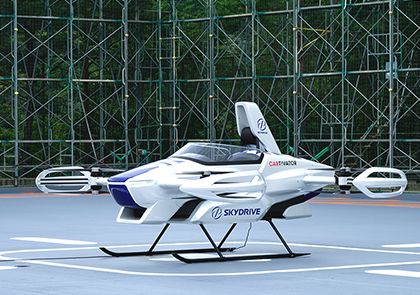
SkyDrive says it has long been their goal to develop the world's smallest flying car model. The SD-03 measures in at just 2 meters high, 4 meters wide, and 4 meters long, making it the smallest eVTOL in the world right now. The one-seater craft takes flight thanks to eight electric motors that power several rotors positioned in four locations around the vehicle's body.
SkyDrive says that if one of the eight motors fail on the SD-03 prototype, the other motors will play a backup role and keep the vehicle flying. The 'car' also has two front lamps and one red tail lamp — the first signs that it might conform to some form of aerial traffic system in the future.
Chief Technology Officer at SkyDrive, Nobou Kishi, has also predicted when he thinks a flying taxi service may come about utilizing their technology.
"The crewed flight that we achieved this time is the culmination of the results that SkyDrive has accumulated so far for technical verification. We have been working step by step, such as designing and testing electric propulsion systems, flight control systems, airframe structures, and introducing equipment for airframe conditions during flight tests. We will continue to work on technological development and type certification so that we can start a safe and reliable flight car navigation service in 2023," Kishi said.
Sky race
Another technology company keenly interested in air mobility is Uber, who just recently launched Uber Air. They have vehicle partners who include Aurora Flight Sciences, Bell, Embraer, Hyundai, Jaunt Air Mobility, JOBY Aviation, Overair, and Pipistrel Vertical Solutions.
Aerospace company Boeing and automobile manufacturer Porsche had also conducted autonomous tests on prototypes of their flying cars back in 2019. They say their vehicle has space for two to four people and a range of 50 miles.
Naturally, due to Boeing's foray into flying car manufacturing, rival Airbus has been tasking their engineers to develop a prototype of their own. There is, therefore, no lack of competition in the air mobility industry. Nonetheless, it is impossible to say which company may go public with a certified consumer experience first.
SkyDrive's two-seater concept vehicle is the company's next focus. The SD-XX is a customer-focused eVTOL that can fly up to altitudes of up to 1,640 feet.
"We are extremely excited to have achieved Japan's first-ever manned flight of a flying car in the two years since we founded SkyDrive in 2018 with the goal of commercializing such aircraft," SkyDrive CEO Tomohiro Fukuzawa said.
"We aim to take our social experiment to the next level in 2023, and to that end, we will be accelerating our technological development and our business development."
Works Cited
sd2020 投稿者: "HOME." 株式会社SkyDrive, skydrive2020.com/archives/3506.
- Details
- Written by: Quintus Potgieter
From the online classroom to the world's leading producer of diamonds by value, many EIT graduates are using their qualifications to contribute to the operations of Debswana Diamond Company mines located across Botswana.
Established in 1969 and owned in equal shares by the Government of the Republic of Botswana and The De Beers Group of Companies, Debswana is one of the world's leading diamond producers and Botswana's largest employer with over 5,000 employees and 6,000 contractors.
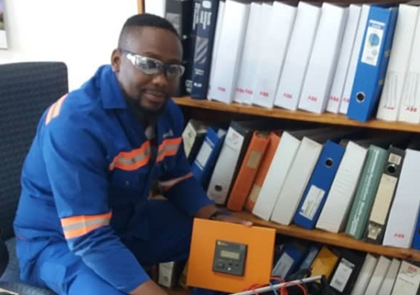
A self-proclaimed 'people-based organization,' Debswana places great value in its employees' training and development, attributing a large part of their success to their ability to develop and sustain a qualified and skilled workforce.
EIT has helped develop the skills and knowledge of eleven Debswana employees. With graduates coming from a range of EIT programs including our 52726WA - Advanced Diploma in Electrical Engineering, 52810WA – Advanced Diploma of Mechanical Engineering Technology, 52708WA – Advanced Diploma of Industrial Automation, and Bachelor of Science (Industrial Automation).
Our unique online learning experience allows students to develop their engineering skills remotely, meaning Debswana's employees can continue working while gaining globally relevant qualifications that further augment their understanding of the industry they work within.
"I chose this course because I have always wanted to be an electrical engineer. My studying experience with EIT has been consistently good. EIT has a lot to offer and is very capable," says 52726 - Advanced Diplomas in Electrical Engineering graduate, Johnson Itumeleng.
"I have learned a lot, and I am executing my daily work in a much more professional manner with what I have learned from EIT."
Johnson started his career in engineering as an apprentice at the Orapa Technical College in 2007. After spending four years as an apprentice, Johnson was employed by Debswana in the Power Distribution sector. He now works as an Industrial Electrician in Debswana's Orapa Mine.
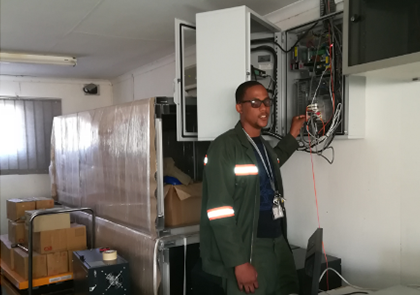
Discovered in 1967 and in operation by 1971, the Orapa Mine is the world's biggest open cast mine. Orapa is currently mining at a depth of 250 meters and is expected to reach 450 meters by 2026.
Orapa is one of Debswana's four mines, along with the Damtshaa, Jwaneng, and Letlhakane operations. Debswana's vision is to be a global bench-mark diamond business. To achieve this, they are setting increasingly demanding targets, embracing industry change, and making meaningful contributions to communities' development around its mines and Botswana at large.
As plans for Debswana's driven future became clear, 52708WA – Advanced Diploma of Industrial Automation graduate Goratoane Rivaldo Rabodietso began studying to keep up with the digitization and automation that he saw encroaching into the industry.
"The most interesting development in our industry is the use of smart instruments which can be calibrated and operated remotely," Goratoane said.
"The use of smart trucks at the mining pit is amazing as well - it can even perform an alcohol test on the driver to check their fitness prior to the operation, which protects the most valuable assets of the company."
Due to its technical and machine-driven nature, Debswana prioritizes the safety of its personnel and operations. All the sites boast impressive records, such as the Jwaneng Mine achieving one of the lowest disabling injury incident rates in Botswana and the Orapa and Letlhakane Mines achieving 2 million fatality-free shifts.
The continuing success story of Debswana Diamond Company is one of excellence and engineering success. EIT is thrilled to have played a part in equipping some of its workers with the skills and knowledge that further assists one of the most notable companies in Botswana's history.
- Details
- Written by: Quintus Potgieter
It is estimated that in the United States alone, elevators travel up to 4.5 million miles every single day. The 31st of July is International Talk In An Elevator Day — it encourages people to engage with someone in an elevator, instead of looking down at their devices and ignoring their surroundings. However, for the first time since ‘Talk In An Elevator Day’ was coined, engineers and scientists are warning against striking up conversations in elevators. The coronavirus pandemic has put the day on pause for 2020 — and there is good scientific evidence as to why.
Amid the pandemic, Richard Corsi, Dean of Engineering and Computer Science and a specialist in indoor air quality at Portland State University in the United States, said: “They should put big signs on the elevator: ‘Do Not Speak.’”
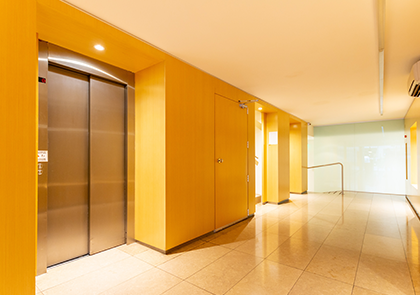
He said this because of the risk run by people who are entering elevators during this time, given the close proximity of occupants. The virus has been particularly widespread in the United States, which recently saw its most significant one-day rise in coronavirus tests; 71,484 tested positive in one day.
Corsi, under the rising coronavirus cases, set out to investigate elevator safety in a pandemic using a method that only an engineer would. He created a model utilizing engineering principles akin to fluid mechanics and cross-referenced them to several kinds of elevators and buildings. Knowing there would be thousands of scenarios, he decided to choose one hypothetical scenario.
In his scenario, a mask-less COVID-19-positive passenger rides the elevator alone from the first floor to the tenth floor. During the ride, they speak on their phone and cough into the elevator car, which spreads the virus around.
When the elevator gets to the tenth floor, they exit the elevator. The doors remain open for ten seconds, close, and then the elevator returns to the ground floor. Taking into consideration the opening and closing of the doors and the subsequent circulation of air, plus the ventilation within the elevator, Corsi estimates at least 25 percent of the particles from the first passenger remain inside.
“The main intent of the exercise was just to show that some level of virus can be sustained in the air beyond an infected person using the elevator. I don’t know whether the dose in an elevator is going to be high enough to pose a significant risk, but I would probably take the stairs if possible,” Corsi told the New York Times.
He tweeted out a hypothetical elevator scenario, including the asymptomatic but infected individual traveling ten stories in a residential building. Evidently, this is an engineer doing their calculations, needing a bit more input from the science still being compiled about the coronavirus. Nonetheless, it is an admirable attempt to work with the facts the public is equipped with at the moment and guesstimating — based on what type of elevator someone is riding - whether or not it may be safe.
Moreover, Corsi’s calculations barely begin to cover the risk the floor number buttons pose to the passengers who touch them. Thankfully, Harvard School of Public Health’s Joseph Allen, an Assistant Professor of Exposure Assessment Science has sound advice on what to do if you do find yourself in an elevator as businesses continue to open up:
- Wear a mask
- Load the elevator in a checkerboard pattern
- Face forward
- Announce your desired floor
- Have the person near the buttons select for everyone, using their knuckles
- No conversations
“Workers want to know whether they can really be safe in an elevator, and building owners want to know whether they get elevator capacity to more than one person at a time. Fortunately, the answer to both is ‘Yes,’” Allen said reassuredly.
Engineers, when probed on elevator safety, are erring on the side of caution due to the constant uncertainty of the coronavirus pandemic. Common sense precautions are becoming more important than waiting for the epidemiologists to aptly inform the global population on the safety of elevator rides. The question about elevator engineering and air circulation and quality is a rare moment where both engineers and scientists can revise some of their studies and come up with answers that can better inform those who ride them.
- Details
- Written by: Quintus Potgieter
It was hailed as the next giant leap for personal transportation. Now, it seems, the idea has become redundant. The Segway PT was a one-person electric vehicle that was brought to market in 2001 — with extreme hype and expectation. Nineteen years later, the self-balancing, two-wheeled personal transporter is being discontinued. It seems that lower consumer demand for the vehicle has convinced Segway to pull the vehicle from its assembly lines, to instead focus on other projects in the mobility industry.
The discontinuation of one product and the evolution of another is seemingly the great challenge for consumer-driven engineering companies all over the world. As technology advances and some technologies become obsolete, one can look back at how those technologies laid the foundation for newer, more advanced technologies to enter the market.

The Segway PT, while an attractive prospect for consumers, was dogged with scathing headlines whenever a crash of the vehicle would occur — resulting in its 'fair share' of highly publicized sensationalist coverage. Nonetheless, Segway inventor and founder Dean Kamen was praised by fellow entrepreneurs at the unveiling of the Segway back in 2001. Apple co-founder Steve Jobs said, about the Segway PT, that it was the most significant invention since the personal computer and Amazon founder Jeff Bezos called it 'one of the most famous and anticipated product introductions of all time.'
"Within its first decade, the Segway PT became a staple in security and law enforcement, viewed as an effective and efficient personal vehicle," said Judy Cai, Segway president, in a recent statement on the discontinuation.
"This decision was not made lightly, and while the current global pandemic did impact sales and production, it was not a deciding factor in our decision."
Associated Press confirms that the Segway PT currently only accounts for 1.5% of the company's profits. The company is, therefore, looking to debut new products that may buoy their company from now on. Even though the PT has seen a downward spiral in demand at the consumer-level, the transportation industry continues to make strides forward.
The Segway company is not disappearing into the history books, however. The company has introduced a new vehicle to the personal transport industry at the Consumer Electronics Show in Las Vegas in January. Their new concept is a self-balancing electric wheelchair and is named the Segway S Pod.
The company is also designing and selling several variants of lightweight scooters. They continue to innovate in the space and seek an audience in the personal transportation industry. PT's story is one of demand, after all. Demand forecasting and predicting a product's life cycle in the market is good business practice, and something engineers have to grapple with within companies.
When to discontinue a product
Companies tend to design products with lessons learned from their previous endeavors. Apple is one of those companies. The company went from designing personal computers to music players to smartphones. After the introduction of the iPhone, some of the company's different music-playing hardware products very much fell out of fashion, and some were promptly discontinued. The iPod Classic, Nano, and Shuffle are no longer being engineered.
Companies usually discontinue certain products because they are in the process of introducing a new line of products into the market that will render the previous product obsolete.
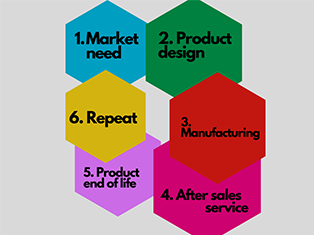
Dr. Kenneth Reid, an Associate Professor in Engineering Education at Virginia Polytechnic, and John Estell, professor of computer engineering and computer science at Ohio Northern University put together an engineering design book, "Engineering Design and the Product Life Cycle: Relating Customer Needs, Societal Values, Business Acumen, and Technical Fundamentals." They sum up the entire engineering design and product life cycle in 9 steps:
- Conceptualization
- Feasibility
- Definition
- Implementation
- Introduction
- Growth
- Maturity
- Decline
- Discontinuance
Business management concepts, coupled with product design and engineering life-cycle theory, are vital concepts to impart on up-and-coming engineers who are entering engineering workplaces or founding engineering startups. Knowing when to introduce products to the market, and when to discontinue, is one of the modern-day challenges for a plethora of engineering companies in a wide spectrum of industries.
For companies that prepare products to sell to consumers and clients, starting the product development process with the end in mind is smart business practice. With how fast technology is advancing, being aware of when to begin producing the next product, and discontinuing the one that came before it is becoming an engineering art form. Reid and Estell conclude:
"Even the most successful, earth-shattering, and monumental designs eventually go out of style, lose their significance or usefulness, or are simply replaced by a superior design. In each case, discontinuance from an engineering standpoint implies more than simply throwing something away. We should anticipate the discontinuance in our design."
Works Cited
Ott, Matt. "Segway, Popular with Police but Not the Public, Hits Brakes." AP NEWS, Associated Press, 23 June 2020, apnews.com/3525b9a69569d57dc41a373e82a8f1cd.
Reid, Kenneth J., and John K. Estell. Engineering Design and the Product Life Cycle: Relating Customer Needs, Societal Values, Business Acumen, and Technical Fundamentals. Momentum Press, 2018.
- Details
- Written by: Quintus Potgieter
A lecturer and a postgraduate student from the Engineering Institute of Technology (EIT) recently virtually attended the 29th IEEE International Symposium on Industrial Electronics (ISIE2020) from the 17th to the 19th of July. ISIE focuses on advancements in knowledge, new methods, and technologies relevant to industrial electronics - along with their applications and future developments. EIT’s two representatives submitted academic papers at the symposium to report their findings on vitally important topics to the industry. Their contributions will spur innovation in the industry, and provide solutions to engineering problems prevalent in both the energy and renewable energy sectors.
Dr. Seyed Morteza Alizadeh started his position as a Lecturer at EIT’s Melbourne campus in July 2019, conducting classes for our Master of Engineering (Electrical Systems) and Master of Engineering (Industrial Automation) courses EIT offers. Soon after he joined EIT, he was promoted to research coordinator with a strong focus on research activities in EIT’s freshly announced Professional Doctorate program. Dr. Alizadeh this year presented two papers at the 29th IEEE International Symposium on Industrial Electronics (ISIE2020). Both of the papers have now been published in the IEEE Xplore Digital Library - a research database for academics in the computer science, electrical engineering, and electronics industries.

“IEEE has a key role in educating, standardizing, and innovating the electronic development industry. It has provided professional engineers across multiple industries with valuable resources and tools,” Dr. Alizadeh explained. “IEEE has an active portfolio of around 1,300 standards which makes it as a leading developer of industry standards in a wide range of technologies used by people in everyday life.”
One of the papers Dr. Alizadeh presented at the symposium was based on the thesis work of one of EIT’s postgraduate students Samuel Afotey. The student completed his thesis remotely under supervision. Entitled ‘Investigation into the impact of Cable Failure localisation methods on the Underground Cable Life Time in a Medium Voltage Distribution Network,’ it was awarded the ‘Best Paper Award’ at ISIE2020.
Afotey’s paper focused on the use of underground cables essential to power distribution networks. The thesis particularly honed in on the impact of underground cable fault localisation methods on the cable lifetime and proposals on cable testing techniques. The paper utilized data from a use case of an electricity distribution network in an urban region of Ghana.
“The testing practices proposed enable to reduce the adverse impact of fault current and harmonic generated during the cable testing process, which is the significance of the presented over the existing cable testing methods,” Dr. Alizadeh explained. “The work helps guide and enables the engineers and designers to carry out an initial assessment on the major causes of cable failure and provide them with the knowledge on how to minimize the adverse impact of underground cable testing,”
Dr. Alizadeh also had a paper that himself and colleagues prepared on renewable energy. IEEE has published the report he unveiled at the symposium. The report titled: ‘A Mathematical Method for Induction Generator Based Wind Power Plant Sizing and Siting in Distribution Network,’ The papers that have now been published will be accessed by engineers and researchers all around the world.
Furthermore, Dr. Alizadeh chaired a conference session on ‘Power Systems and Smart Grids’ at IEEE’s symposium. He is intrigued by the development of renewable energy-based power plants that are being engineered to minimize the number of fossil fuel burning technologies existing in energy industries worldwide.
“In my point of view, the renewable energy-based power plants have been significantly developed, and there are many large-scale on-going projects in many countries to increase the penetration of renewable energy sources for producing electricity. However, in many countries, the existing renewable energy-based power systems have the capacity of supplying the intermediate or peak load while the base load is still provided by fossil fuel-fired power plants. This has increased the environmental issues such as air pollution and global warming,” Dr. Alizadeh said.
At the conference session he chaired, Dr. Alizadeh was fascinated by an engineer from Bosch Company who presented a paper titled ‘Load Profile Cycle Recognition for Industrial DC Microgrids with Energy Storage Systems.’ The hope is that, especially in developing countries, that renewable energy technologies can form part of the base-load of countries’ energy capacity, so they don’t have to rely on fossil fuels as much.
“The investigation of different aspects of renewable energy power systems, for example, power quality and voltage analysis, frequency stability and technical issues for grid interconnection in the renewable energy-based power systems, is a very exciting research prospect in the power engineering field and much research has either already been completed or in progress,” Dr. Alizadeh concluded.
- Details
- Written by: Isabella Foster
On the 30th of May 2020, after four years of preparation, astronauts Robert Behnken and Douglas Hurley lifted off at 3:22 p.m. EDT in the SpaceX Falcon 9 rocket. Launching from Cape Canaveral in Florida, the monumental flight marked the first time in history that NASA astronauts have launched from American soil in a commercially built and operated American crew spacecraft on its way to the International Space Station.
“This is a dream come true for me and everyone at Space X,” said Elon Musk, chief engineer at SpaceX. “You can look at this as the results of a hundred thousand people roughly when you add up all the suppliers and everyone working incredibly hard to make this day happen.”
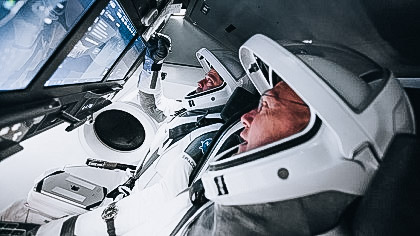
Known as NASA’s SpaceX Demo-2, the mission is described as an end-to-end test flight to validate the SpaceX crew transportation system. Acting as the first test of SpaceX’s Crew Dragon with astronauts aboard, the mission will hopefully pave the way for the regulation of crew flights to the station as part of NASA’s Commercial Crew Program.
Meet Robert Behnken and Douglas Hurley
The road to the launch of Demo-2 started over 20 years ago for chosen astronauts, Robert ‘Bob’ Behnken and Douglas ‘Doug’ Hurley. Both members of the NASA Astronaut class of 2000, Bob and Doug were already longstanding friends and lived almost parallel lives, making for the perfect team to break NASA’s nine-year hiatus of launching astronauts from US soil since the retirement of the last space shuttle in 2011.
Both men gained undergraduate degrees in engineering during their formative years. Bob earned two bachelor's degrees in physics and mechanical engineering in 1988 and 1992, a master's degree in mechanical engineering in 1993 and a doctorate in mechanical engineering in 1997. Doug graduated with a bachelor of science degree in civil engineering in 1988.
Despite going to different training schools, Doug and Bob went on to both be subsequently trained as military test pilots and would achieve the rank of colonel - Hurley in the Marine Corps, Behnken in the Air Force. This has been known as a standard background for Nasa’s astronauts since the days of their first intakes.
Together, the men had over 7,000 hours of flight experience in 25 different types of aircraft when they were selected to the same NASA astronaut class in July 2000. Over the next twenty years, Bob and Doug would continue to train side by side and gradually build the bond that NASA would trust with the responsibility of manning Demo-2.
Despite the hype surrounding Elon Musk's historic launch, the two NASA astronauts have largely hidden away from the spotlight. Adding to their list of similarities, Bob and Doug are also both married to fellow astronauts with each a young son. They even share the same taste in music.
“I wanted to make sure everyone at SpaceX understood and knew Bob and Doug as astronauts and test pilots but also as dads and husbands,” said Gwynne Shotwell, SpaceX’s chief operating officer. “I wanted to bring some humanity to this very deeply technical effort as well.”
Lifting off from Launch Pad 39A, the two Astronauts accelerated to approximately 27,000 km/h before Crew Dragon followed its intercept course with the International Space Station. Bob and Doug were welcomed aboard the station after 19 hours of flight time, joining the Expedition 63 crew and becoming the first astronauts in history to ride a commercial craft into orbit.
The Demo-2 mission will be the final major step before NASA's Commercial Crew program certifies Crew Dragon for operation missions to the space station, laying the groundwork for future exploration of the Moon and Mars.
However, despite attention obviously being on the successful launch of the Demo-2, the reason for the SpaceX mission should not be forgotten. The two astronauts are there ultimately in the service of science and international research. Bob and Doug will take part in installing a new hardware platform called Bartolomeo, designed by the European Space Agency and Airbus to enable the ISS to host extra science experiments from teams all over the world.
“It was incredible,” NASA astronaut Bob Behnken said of the launch, moments after the spacecraft reached orbit. “Appreciate all the hard work and thanks for the great ride to space.”
In addition to the launch, SpaceX also successfully landed the Falcon 9 rocket booster. The booster is the large lower portion of the rocket, which re-entered the Earth’s atmosphere and landed on the company’s drone ship in the Atlantic Ocean. SpaceX has landed its Falcon 9 rocket boosters 45 times.
“This just the beginning; it’s only going to get better,” Bob Cabana, director of NASA’s Kennedy Space Center, said before the launch.
What’s next?
The future of space travel is tipped to be exciting. Elon Musk founded SpaceX in 2002 with the ultimate goal of colonizing Mars. Before that, however, SpaceX is still contracted to assist NASA with five more crewed missions to the International Space Station.
The SpaceX and NASA partnership on the 30th of May taught us all something about rocket launches: No matter how many times a launch is performed, there is always an edge of excitement. Sparking the interest and curiosity of millions around the world, the human journey into space is one that never ceases to amaze.
A new era of space flight seems to be upon us, and that means that more engineers will be required to continue the development of one of the most exciting engineering sectors ever created. SpaceX seems to be leading the charge on space engineering but what else can we begin to expect?
With the continued progress of programs such as SpaceX and the upcoming opportunities being offered by NASA, there will be plenty of milestones made in the coming years. Each little discovery and invention will pave the way to a more space-filled future.
Works Cited
“NASA and SpaceX: Journey to the Future: NASA and SpaceX: Journey to the Future.” Discovery, go.discovery.com/tv-shows/nasa-and-spacex-journey-to-the-future/full-episodes/nasa-and-spacex-journey-to-the-future.
“Updates.” SpaceX, www.spacex.com/updates/crew-demo-2-mission-update-5-30-2020/.
- Details
- Written by: Quintus Potgieter
A passionate electrical engineer and educator, Dr Yuanyuan Fan is a course coordinator and on-campus lecturer at EIT’s Perth campus in Australia, working to develop the future generation of industrial automation and electrical engineers.
Dr Fan studied at the North China Electric Power University, earning her bachelor degree in 2010, and subsequently her master’s degree in 2013. However, she had already been actively working in the electrical engineering sector as far back as 2006. She says that her passion for engineering stemmed from her love of physics at a young age.

“I chose to study engineering because my favourite subject in school was physics. Based on my understanding at that time, engineering was the closest career path in proximity to physics - especially the practical element of physics. I knew I chose the correct area the moment I started my bachelor degree,” she said.
Dr Fan has extensive knowledge in power system design, control, modelling and simulation. In her career, she has researched renewable energy, microgrids, HVDC and smart grids. She has published reports on offshore wind power and is passionate about the move away from environmentally damaging technologies to more sustainable and renewable means of powering the world. She explains:
“As far as sustainability is concerned, renewable energy is the future. The challenges in renewable utilisation are massive, although there are renewable projects all over the world. It is an area that deserves the most attention right now.”
In 2017, Yuanyuan undertook the challenge of earning her PhD in Electrical and Electronics Engineering at Curtin University in Perth, Western Australia and encourages young women to not be deterred from pursuing engineering careers.
“STEM should equally be for both boys and girls in schools. There is no reason that girls should be made to feel excluded from any subjects.” Dr Fan says.
“I was motivated to make a difference in society. That’s what kept me going,” she adds.
Since joining EIT in 2017, Yuanyuan has busily spent her days developing course curriculum, lecturing in the fields of electrical and automation engineering as well as supporting both online and on-campus higher education students through their engineering journeys.
EIT is thankful to our talented and driven academic staff for the hard work they put into delivering outstanding engineering education. Dr Fan is a leading example of dedication to her field whilst also actively contributing to the future of the engineering industry.
Find out more about studying on-campus in Australia with EIT.
- Details
- Written by: Quintus Potgieter
Opportunities in industrial automation are expected to exponentially increase as the global pandemic highlights the need to speed up the adoption of automation to ensure productivity. The shift in trends from traditional techniques to digitized systems has revolutionized supply chain management. Robotics and automated processes are helping companies operate more efficiently and are creating new avenues of work for engineering technicians, technologists and professional engineers. Companies are investing in automation technologies, such as robotics, smart sensors, industrial digital computers, and more, to keep their operations efficient. Automotive, retail, transportation & logistics, manufacturing, mining and the energy sectors have a renewed appetite to increase automated processes for cost optimization and productivity.
Adversely, instead of slowing down, some essential industries have had to increase production amid global lockdowns. The pandemic has highlighted the increasing need for industrial automation to keep industry operating as crises threaten more shutdowns in the future.
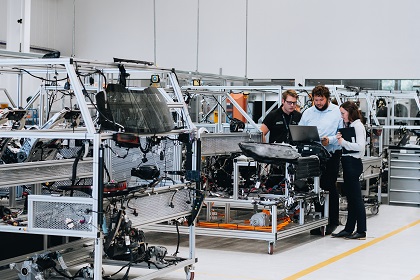
MarketandResearch.biz has posted a new report on the ‘Global Conveyor Equipment Market by Manufacturers, Regions, Type and Application, Forecast to 2025’. They report that manufacturing plants specifically are currently looking into the following technologies that might keep their supply chains in business:
- Automated Guided Vehicle Systems (AGV)
- Automated Storage & Retrieval Systems (AS/RS)
- Conveyor & Sortation Systems
- Robotic systems
Meeting the employability demands of automation
QS, a leading global education network has compiled a report entitled ‘How Artificial Intelligence is Influencing Graduate Employability’. The report encourages students to think about how artificial intelligence (AI) and machine learning (ML) may replace jobs within industries and alludes to the fact that students need to master the fundamentals of AI and ML to future proof their careers. The report points out that employers are seeing the cost-benefit of employing and utilizing technologies that utilize AI. The report reads:
“Overall, 67% of employers feel that by the year 2030 AI will indeed provide a more cost-effective alternative to highly skilled jobs, showing that almost two-thirds regard AI as a threat to the graduate labour market. “
However, most experts are confident that AI-based software systems will not replace highly skilled positions, but rather help augment the work that engineers and workers undertake within an organization. Therefore, staying abreast of the technical side of automation software and technologies is important for the technician, technologist or engineer. The ability of employees to be ready and prepared for the next generation of emerging jobs, as a consequence of automation, is the mark of a transformative engineering professional.
The industries showing immediate automation appetite
Oil and Gas company Cairn India accounts for approximately 25 per cent of India’s domestic crude oil production. India has had one of the more stringent lockdowns in the world. Cairn India went from having a mammoth 7,500 personnel on-site, to having just 1,500 personnel since the lockdown was announced.
The oil industry, in general, saw incredible swings during the global lockdowns. Not only did the price per barrel of oil stoop to a historic low, but engineers were also forced off plants. “The COVID-19 pandemic has had a profound impact on lives and livelihoods. The engineering work landscape has been rapidly evolving, and the pandemic has accelerated and changed the landscape in ways we are only beginning to understand,” says ASME Executive Director/CEO Tom Costabile. “Engineers are applying technologies including artificial intelligence, robotics, and 3D printing to help respond to the public health crisis, and also to adapt processes in many industrial sectors and transform supply chains for the future.”
Talking to the Economic Times India, the chief digital officer of Cairn, Anand Laxshmivarahan said: “In the post-COVID-19 world, the focus has shifted to cost optimization; the only place companies are willing to invest is in automation.”
The Economic Times India says Tata Steel, Ceat Tyres, Maruti, Mahindra, Toyota and Tata Motors have looked into how to continue further automating their production lines as a consequence of the pandemic and lockdowns. Human resource officers from those companies quizzed on how the pandemic was affecting them are all clear: digitisation and automation is now the name of the game. The renewed push to automate even more of the automotive sector is in line with the reports on the Global Conveyor Equipment Market forecasts.
When companies invest in new technologies, engineering professionals confront new challenges in their employment and this highlights the need for high-quality training and education in the area. While several pathways will lead to a career in industrial automation engineering, most universities only offer this specialisation as a Masters. However, EIT offers advanced diplomas, bachelors and masters specifically focussed in industrial automation. Or, for those who wish to upskill via an intensive short course, EIT’s three-month online Professional Certificate of Competency in Programmable Logic Controllers (PLCs) & SCADA Systems highlights recent developments, using case studies, and the latest application of SCADA, PLC technologies and fundamentals.
Works Cited
Bhattacharyya, Rica, and Lijee Philip. “Automation Key to Post-Pandemic Production.” The Economic Times, Economic Times, 27 Apr. 2020, economictimes.indiatimes.com/news/company/corporate-trends/automation-key-to-post-pandemic-production/articleshow/75395665.cms?from=mdr.
“Global Conveyor Equipment Market 2020 by Manufacturers, Regions, Type and Application, Forecast to 2025.” Marketandresearch.biz, www.marketandresearch.biz/report/130737/global-conveyor-equipment-market-2020-by-manufacturers-regions-type-and-application-forecast-to-2025.
- Details
- Written by: Quintus Potgieter
The Engineering Institute of Technology (EIT) is committed to encouraging women to join the engineering industry and supporting our students throughout their respective journeys.
In 2017, the World Economic Forum released reported that while approximately 20% of engineering graduates are women, only 13% of the engineering workforce is female. While the industry is still very much dominated by males, it is still worth reflecting on the work that has already been done by females to change this, one step at a time.
Australia’s first female electrical engineer, Florence Violet McKenzie, had an incredible career that was characterized by her contribution to encouraging women to become engineers, and for her wireless communication efforts in World War II.

In the early 1930’s she was the only female member of the Wireless Institute of Australia, which is where she took her electrical wiring knowledge and expanded on that by studying the chemistry of television. She joined the Women’s Engineering Society — the only society in the world, pushing for the representation of females in the engineering industry — and from there, she founded an educational initiative named the Electrical Association for Women.
When the war broke out, she used her qualifications and teaching skills to form the Women’s Emergency Signalling Corps, to help women become skilled in wireless communications, which would assist the military in the war. She and some of her trainees managed to form the Women’s Royal Australian Naval Service (WRANS) – this was the first time that women were allowed to join the navy, and the urgent need for telegraphists meant they were relied upon heavily. By the end of the war, WRANS represented 10% of the entire Royal Australian Naval Force.
By training up thousands of women in telegraphy, Florence paved the way for women to pursue careers in the Science, Technology, Engineering, and Mathematics (STEM) industries.
EIT wants to continue creating female spiritual successors of Florence Violet McKenzie in the modern engineering world. We hope to cultivate the engineering skills of school leavers and already-working engineering professionals and help elevate them into long-lasting engineering careers.
One of those ‘spiritual successors’ is EIT’s Student Ambassador for 2020, Mildred Nanono. She is a Control and Instrumentation Engineer at Eskom Uganda Limited (EUL), who completed her Master of Engineering (Industrial Automation) with us in 2018.
She said she finds pride in her work, which involves keeping the lights on for 40% of the Ugandan nation.
“I had always wanted to be part of a team, contributing to the power sector. Given the small number of ladies in the sector, I was motivated to join the male-dominated field to make my contribution toward national development,” Mildred said.
Tough times call for innovative measures
EIT has continued to deliver courses as usual throughout the COVID-19 pandemic, despite many institutions being forced to close, thanks to our revolutionary online training methodology that we have developed over the past 15 years.
With our practical online learning model, there is no reason why educating women in engineering has to cease just because of tough times — something Florence Violet McKenzie masterfully demonstrated during World War II.
EIT’s Deputy Dean, Indumathi V, is a shining example of a woman who is ceaselessly passionate about engineering education and ensuring women feel empowered enough to consider a career in the industry.
“I am a strong advocate for girls and women in engineering, also encouraged by being a mum of two young girls and a boy myself. I strongly believe that it is important for young girls from a schooling age to be aware of the various career options and study pathways available to them and to ensure they understand that they are capable of taking on technical roles and STEM fields,” she said.
If you are looking to study engineering and have identified a course you think would be perfect for growing your skills, you may be eligible for a scholarship. Women studying our higher education degrees can apply for our Women in Engineering scholarship. If successful, you will receive mentorship from one of our female engineers, plus a financial incentive. Both current and prospective students can apply for these scholarships.
- Details
- Written by: Quintus Potgieter
Roads are an essential part of everyday life and crucial to economic development. Transportation networks require well-maintained roads; however, the maintenance of roads is a resource-heavy job. It is a costly exercise for local governments to constantly repair roads, and therefore, the sector is primed for innovation.
 The techniques involved in the construction of roads are in flux and being revolutionized across the globe. Keeping abreast of the latest methodologies may be daunting for engineers; however, the Engineering Institute of Technology is ready and able to equip engineers with the skills they need to thrive in the industry.
The techniques involved in the construction of roads are in flux and being revolutionized across the globe. Keeping abreast of the latest methodologies may be daunting for engineers; however, the Engineering Institute of Technology is ready and able to equip engineers with the skills they need to thrive in the industry.
A technological leap in road repair
Experts predict that soon small autonomous unmanned vehicles may be dispatched to patch cracked and potholed roads. Others say the key to road construction and maintenance in the future lies in self-healing concrete, making disruptive road works a thing of the past.
Purdue University’s Lyles School of Civil Engineering has created ‘smart’ concrete. This new technology allows concrete-paved bridges and highways to alert engineers when extensive damage has occurred.
Luna Lu, an associate professor at Purdue, explains that Purdue is ‘investigating different types of highly porous, sandlike materials called internal curing agents to mix into concrete.’ When the road begins cracking, the agents absorb water and cause a chemical reaction. The reaction starts to ‘heal’ the concrete by creating a solid that seals the crack.
The university is silent on what specific elements go into their self-healing concrete, but are promising that their research is being compiled and readied for publication soon.
The university is confident that the concrete could even cut down traffic jams and the length of road closures for repairs as a result of its crack-identification capabilities. The smart concrete could “talk to the engineer,” says Lu, visually showing them when preventive maintenance is needed.
Engineering researchers are hoping that self-healing road materials will help roads last longer. The aim is to have them last up to eighty years without the need for maintenance. Getting to that point will involve a ton of hard work.

Right now, however, sustainability in road construction is becoming paramount due to the environmental impact of road construction. The protection of landscapes is now a huge consideration in the construction industry, and roads need to be constructed as greenly as possible.
Learning the fundamentals
Engineers may still be pondering the future of roads; however, one thing is for sure: engineers will always need to be proficient in the fundamentals of road construction. Technolgy around road construction is developing rapidly, so it is also vital for engineers attached to these projects to be ahead of the learning curve, by undertaking regular professional development.
At the Engineering Institute of Technology, we are delivering a three-month online professional development course in the Fundamentals of Road Construction. The course covers the basic principles and concepts used in the management, planning, design, operations, and construction of roads. It also consolidates the cutting-edge methodologies being employed by construction industries across the globe. The fundamentals you will learn, include:
- The factors involved in the planning of the roads
- How to categorize and prioritize the properties of alternative road materials.
- Earthwork operations
- How to propose drainage and pavements systems
- Roadside aspects
The course ensures that students receive both theoretical knowledge and practical experience in the construction, operability, design, and maintenance of road facilities. It covers the appropriate maintenance measures, adaptation, and improvement of roads - most importantly, how to ensure safety for motorists as well.
EIT’s Professional Certificate of Competency in Fundamentals of Road Construction includes modules on control of surface water drainage, the provision of underground drainage, the provision of safety barriers, and signs and lighting for the safe operation of the road.
Works Cited
Engineering, Interesting. “Simple Self-Healing Roads Can Last Up to 80 Years.” Interesting Engineering, Interesting Engineering, 12 Mar. 2018, interestingengineering.com/self-healing-roads-last-80-years.
Purdue News Service. “Enabling Highways and Bridges to Prevent Their Own Damage.” Purdue University News, www.purdue.edu/newsroom/releases/2020/Q2/enabling-highways-and-bridges-to-prevent-their-own-damage.html.
- Details
- Written by: Elyse Simich
The ‘future of work’ is being shaped by a powerful force; the growing adoption of online technologies and artificial intelligence in the workplace. This year has seen the world as we once knew it change rapidly, with the majority of the globe going into an unprecedented lockdown due to the COVID-19 pandemic. While it is easy (and expected) to feel anxious when there is so much uncertainty and change, there is an opportunity to upskill or skill shift in technology and leadership to meet the requirements of continuously evolving workplaces.
The COVID-19 pandemic has demanded that workplaces and education providers adapt to new technologies. These technologies have allowed people to work and study from home while maintaining consistent levels of communication and collaboration.
 The pandemic has also painted a picture of a world where automated machines increasingly replace workers so that companies can become more efficient, ensure fiscal responsibility, and maintain productivity. For those caught up in the gig economy, it has exposed a fundamental lack of job security paired with the precarious nature of work. While governments, companies, and employees have been preparing for the disruption of the Fourth Industrial Revolution for some time, this pandemic has likely accelerated advances in technology beyond what we expected.
The pandemic has also painted a picture of a world where automated machines increasingly replace workers so that companies can become more efficient, ensure fiscal responsibility, and maintain productivity. For those caught up in the gig economy, it has exposed a fundamental lack of job security paired with the precarious nature of work. While governments, companies, and employees have been preparing for the disruption of the Fourth Industrial Revolution for some time, this pandemic has likely accelerated advances in technology beyond what we expected.
By recognizing these challenges to the labor market, we now have an opportunity to look at the bigger picture and lay the foundations for a more resilient future, according to the World Economic Forum.
This acceleration in digitization and automation means upskilling and reskilling is necessary to ensure employability in ever-evolving workplaces. Key skills in these areas consist of coding and programming, machine learning and artificial intelligence, industrial data communications, and instrumentation, automation and process control.
At the Engineering Institute of Technology (EIT), we believe in instilling our students with cutting-edge skills that the industry demands. These skills are taught via our unique online delivery methodology, which allows students to connect with each other and their lecturer in real-time during the live and interactive webinars. State of the art technologies, such as remote laboratories and simulation software, enable students to gain practical knowledge that can be immediately applied in the workplace. While we offer formal qualifications from diplomas and advanced diplomas, through to bachelor’s and master’s degrees, we also offer three month short courses in micro-skills to help engineers future-proof themselves as the industry continues to evolve.
Being able to problem-solve in a digitized world is becoming increasingly important. Through EIT, engineers and technicians can study python programming to help them solve engineering problems, write automation scripts, and manipulate and analyze big-data.
As businesses become increasingly automated, engineers need to have a thorough understanding of the technologies used to achieve this. Industrial networking and industrial data communications systems are essential to keeping electronic and digital data transferring between devices. Therefore, it is crucial that those who work with these systems understand the components and can identify, prevent, and troubleshoot any problems. Likewise, engineers who work with systems that are becoming increasingly automated must have practical knowledge regarding the selection, installation, and commissioning of industrial instrumentation and control valves. It is also important that they have a fundamental understanding of PLCs and SCADA systems. EIT offers short courses in these areas that allow you to upskill in a practical way, so you can immediately implement what you have learned, to become more efficient at your job.
It is not only digital skills that need to be enhanced, though; it is equally important for engineers to hone their ‘human skills.
Throughout this pandemic, employers have had to work harder to show support and leadership. However, this crisis has given them the opportunity to consider their employees’ needs on a holistic level, to keep them engaged and motivated physically, mentally, and emotionally. Leadership has become increasingly important as processes have had to become streamlined to facilitate quick decision making, new technologies have been quickly introduced, and teams have had to find new ways to collaborate despite being physically apart.
According to Forbes, times like these expose true leaders as they are forced to step up and perform beyond their usual duties.
“Throughout a crisis, leadership is more important than ever. It is also clear which leadership behaviors are most effective. In the toughest times, the leaders who excel are those who communicate clearly, stay calm and strong, demonstrate empathy, think long-term and take appropriate decisive action. It is likely these difficult times will filter out leaders who are less stellar.”
As companies continue to implement new technologies and automate certain practices post-pandemic, employers and managers will be expected to continue demonstrating strong leadership, to maintain the trust and faith of their teams. EIT has created a three-month online course in Project Management for Engineers & Technicians, to help engineers lead their teams effectively and efficiently manage projects.
Now is the time to look towards our futures and consider where our careers may take us.
- Details
- Written by: Quintus Potgieter
In the world of education and training, stereotypes can create negative perceptions around particular lines of study or work. The Science, Technology, Engineering, Mathematics (STEM) fields are rife with stereotypes that can dissuade young people from taking an interest in these industries, even though these jobs are becoming increasingly essential.
With the rise of technology and automation, engineering careers are becoming more diverse and more applicable across a variety of industries. Therefore, simplistic and generalized views of who engineers are and what the engineering world entails are damaging to the perception of the industry — as well as being simply untrue.

One area that engineering has expanded into is the healthcare industry. Biomedical engineering is bridging the gap between these two fields, by using technology to create, maintain, repair, and operate essential medical equipment.
Kym Rykers, a board member at the Australasian College of Physical Scientists and Engineers in Medicine in 2016, compiled a study named ‘The impact of diversity, bias and stereotype: expanding the Medical Physics and Engineering STEM workforce.’
She writes: “The demand for individuals with a science and maths based education is growing worldwide with predictions that over 20% of all future occupations will require at least a basic degree with a maths and science major. The diversity of jobs is increasing with new occupations also being created; with each year, there will be greater competition to persuade talented people to take up ACPSEM (Medical Physics and Engineering) supported careers.”
However, Rykers points out that some educators in the schooling sector are still too slow in reforming to prevent the phenomenon known as the ‘engineering spiral of death.’ This occurs when a student loses interest in engineering before high school and cannot recover the love for STEM - which potentially hurts their future employment prospects. Teachers have an immense challenge ahead of them as technology continually demands more and more fired up graduates who are ready to tackle the complex tasks that the future is presenting.
The situation is even more dire for women. Over the past decade, the industry has pushed to include more women in both entry and senior positions. Diversifying these traditionally male-dominated workplaces is one way of undoing age-old stereotypes that have characterized some industries. However, Rykers states that girls need to be included and encouraged to participate in the STEM fields from a much younger age.
“The reasons behind the low numbers of girls and women taking up careers based on science and maths is due to a host of factors which start impacting participation in primary school. Numbers drop further as women progress through to university and move into employment. This attrition means a significant cohort of talented women are lost to the science community, and it is a loss we can ill afford. To meet the continued need, it is imperative to address this loss.”
At the Engineering Institute of Technology (EIT), a number of our Course Coordinators and lecturers are female engineers. Our Deputy Dean Indumati V recently gave us her views on the issue of attracting early interest in the pre-schooling years of girls.
“Education is the foundation to a better society. Engineering is the field that is a pillar in providing economic, environmental, health, and security benefits to society. I am a strong advocate for girls and women in STEM,” she said.
“I am encouraged by being a mum of two young girls and a boy myself. It is important that girls are aware of any capabilities that they need to develop from a young age to nurture their interest in the field. I have run some successful initiatives and actively participate in events that promote girls in STEM.”
In order to keep moving forward and continue attracting people with a broad range of personality types, interests, and backgrounds into the STEM field, work still needs to be done. If, from a young age, all students are encouraged to feel positive about their prospective futures in engineering, many of the false generalizations will fall away. With how varied the engineering field is becoming, employment opportunities in the sector are still being established. There has never been a better time to study engineering.
- Details
- Written by: Quintus Potgieter
Human ingenuity, and hobbyists — that’s what the world needs right now, aside from the medical professionals who are on the front lines of the coronavirus pandemic.
As hospitals around the world rush to take stock of the medical equipment they have at their disposal, engineers and engineering companies have been finding ways that they can contribute to the fight against COVID-19.
It turns out that the hobbyist engineer who has a 3D printer at home could potentially be an integral player in manufacturing items that can help secure public health. Kasey Martin, our in-house developer at the Engineering Institute of Technology (EIT), is putting his 3D printers to good work.
He currently works in the Philippines, which has put contingency plans into place to mitigate the spread of coronavirus. They are now in enhanced community quarantine, meaning the government has imposed a strict home lockdown with only essential movements for necessities and health services permitted.
“There has been an increase in checkpoints and uniformed personnel on the streets enforcing the quarantine. There has also been a rise in patients admitted to our health facilities. There is a great demand for any form of personal protective equipment (PPE),” he said.
Kasey had procured some 3D printers (the AnyCubic i3 Mega, the Creality CR-10, and Creality CR-2020) in a previous project that saw him printing parts for a weather station. When he heard that there was a shortage of PPE for the health workers and other essential workers, he jumped into action. He frantically searched for 3D printing templates for face shield frames.
One of the first considerations when printing a face shield frames is what filament to use and how fast it can be printed. Another factor is how safe the filament is for human use.
He explained, “For faster rollouts and ease of prints (easiest of all filaments types to use), we use standard PLA filaments. PLA stands for polylactic acid that is a bioplastic that usually comes from cornstarch as its raw material. It does not have any fumes (as opposed to ABS plastic) when printing, so it is safe for printing 24/7 in an enclosed office during this crisis.”
They then accessed open source templates that could be plugged into the 3D printers’ software.
“This is where the fun story starts. While thinking of a way we can help our front liners with alternative PPEs, we came across a Facebook group of 3D printing hobbyists. They were calling for help in 3D printing face shield frames that could be fitted with acetate sheets.”
“These face shields would then be given to front liners in the field and health centers nationwide. They did mention that, at first, the model required 3 hours to print. But the community also chipped in and gave them more optimal 3D printer profiles that made the frame print in a little over an hour!”
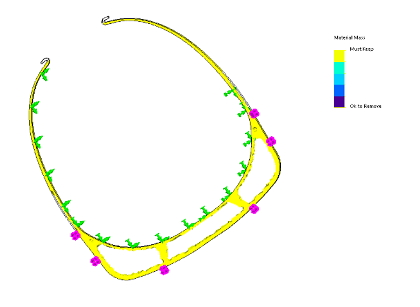
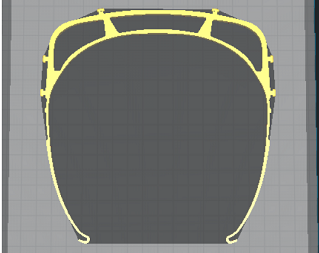
The crowdsourcing nature and the refining process has led to a much better-printed frame and enabled the printers to print quicker. The first iteration of the frame proved unsafe to use in a situation involving a COVID-19 patient.
To make a safer frame, he utilized a manufacturing methodology he learned from a mechanical engineer friend of his: topology optimization. He explained:
“Topology optimization mathematically optimizes your material layout based on certain constraints you put into it, like material load, for example.”
After optimizing the design and sticking to the directions of what would be safest to prevent essential health professionals from getting COVID-19, they produced a much safer frame.
The benefit of the new design was that a pair of frames could be printed at once, on a 200x200mm print bed. They posted their findings to social media and got positive feedback from friends in the medical field. Kasey and his team simply put a 0.52 mm ‘roofing’ on the frame that, if worn, would prevent any dangerous droplets from entering the shield.
The team managed to get a pair of frames printed in 40 minutes. Kasey has been sleeping over in the office to ensure that they produce as many frames as possible.
“We can produce about 50-60 face shield frames per day. We do most of our printing as fast as we can during the daytime, starting new prints every 1.5 hours. At nighttime, we slow down a bit and schedule prints every 3 hours so that we don’t mess with our sleep too much. Sleep is essential during the crisis. We can’t help other people if we get sick as well.”
Kasey says that other hobbyists can get involved in creating quality PPE equipment for health officials. Developing nations are specifically seeking assistance from the public.
“We have shared our modified design on Thingiverse so everyone who wants to contribute can freely download and get their printers to work. We are also in the works of forming an alliance of 3D printing hubs that should help cater to the number of requests we’ve been getting from various groups requesting these face shields.”
You can find Kasey’s design here.
- Details
- Written by: Quintus Potgieter
Reducing emissions in the mining sector is one of the key focuses for mining companies globally. The recent bushfire events in Australia have sparked conversation around how greatly fossil fuel emissions have affected climate change. The changing climate, experts say, is one of the reasons for the recent bushfire crisis that impacted the entire country.
Consequently, Rio Tinto will be spending US$98 million on a new solar plant at their US$2.6 billion Koodaideri iron ore mine in Western Australia. There will be extra expenditure for a battery energy system for the entire Pilbara power network, too.
 The solar photovoltaic plant will generate 34 megawatts and will supply the brunt of Koodaideri's electricity demand during peak operation times. The solar facility will see 100,000 panels absorbing the sun during the day, with the 12MWh battery storage system charging up.
The solar photovoltaic plant will generate 34 megawatts and will supply the brunt of Koodaideri's electricity demand during peak operation times. The solar facility will see 100,000 panels absorbing the sun during the day, with the 12MWh battery storage system charging up.
The solar plant will be fully in-service by 2021 - the year the mine becomes active too. Rio Tinto Iron Ore CEO Chris Salisbury told media, "The construction of our first solar plant in Pilbara is a significant milestone for the business and an important step in reducing our carbon footprint in the region. We are investigating additional renewable energy options in the Pilbara, as well as other opportunities to reduce emissions across our entire global portfolio, building on the 43% reduction in absolute greenhouse gas emissions since 2008."
Rio Tinto has been investing in solar photovoltaic setups with energy partners in Queensland, but the Koodaideri mine setup will one hundred percent owned by the company. They are working in tandem with the Western Australian Environmental Protection Authority to see where else they can decarbonize their mining operations.
They are contemplating wind projects, and further lithium-ion battery projects that can drive their carbon footprint down. Australian mining companies have been opting to build solar-gas hybrid power generation microgrids that power their operations. Mining companies are trying to meet the target of having 50% of the industry powered by renewables as soon as possible.
Juwi, a German company specializing in wind and solar energy, is trying to get more renewable energy into mines. It is hoping that one day mines might be powered by 100% renewable energy.
Dave Manning, juwi's global head of hybrid, told ESI-Africa, "Mines are most interested in solutions that can reduce costs and carbon emissions. The most advanced options to deliver this are hybrid systems that integrate solar, wind and batteries with diesel, gas or heavy fuel oil generators, without compromising reliability or power quality. We are already starting to see mines transition to fully electric operations, as there are multiple benefits. The economics of a 100% renewable energy site is almost there, and with the introduction of hydrogen, we are almost certainly going to see 100% renewable energy-powered operations in the near future."
Training engineers in renewables
Getting engineers trained up for the complexities of technological changes within the industry is what the Engineering Institute of Technology (EIT) is all about. As companies move away from fossil fuels, the electrical engineering industry continues to be transformed.
Renewable energy technologies are a specialist area that is forming a critical part of the industry's future. To understand the complexities of renewable energy systems, engineers who trained over a decade ago may need to upskill.
EIT delivers a live and interactive online Australian accredited 52764WA - Graduate Certificate in Renewable Energy Technologies. This program will equip you with the advanced skills and knowledge in the latest advanced technologies in power generation. Renewable energy is only becoming more critical in the mining industry, and therefore, mastering renewables is in the best interest of the 21st-century engineering student. Even working engineers can become proficient in these technologies by undertaking such courses.
EIT also delivers practical online programs in electrical engineering, and in electrical and instrumentation (E&I) engineering in the mining industry.
Works Cited
Batten, Kristie. "Rio Tinto to Build US$100M Solar Power Plant." Mining Journal, 17 Feb. 2020, www.mining-journal.com/sustainability/news/1381112/rio-tinto-to-build-ususd100m-solar-power-plant.
Zyl, Nicolette Pombo-van. "Key Renewable Energy Trends Have Proven to Power Mining." ESI, 4 Feb. 2020, www.esi-africa.com/industry-sectors/future-energy/key-renewable-energy-trends-have-proven-to-power-mining/.
- Details
- Written by: Quintus Potgieter
Lucinda Krige is a South African inspiration. She is a qualified Marine Engineer Officer who, since 2003, has been working for renowned seafood processing company Sea Harvest. She currently works as a HR Business Partner in Learning and Development at Sea Harvest.
She was the first woman to qualify as a Chief Engineer in the fishing industry in South Africa. The sector produces 80 million tons of food and employs 40 million people across the globe.
Sea Harvest is a company that was established in 1964 on the Atlantic West Coast of South Africa. They are headquartered in Saldanha in the Western Cape. They catch and package seafood, exporting it to 22 countries.
 Lucinda, being the first female engineering cadet in the fisheries industry to rise up the ranks to become a Chief Engineer, is a role model to the many unemployed youths in South Africa who are desperately seeking the kinds of opportunities she has worked for.
Lucinda, being the first female engineering cadet in the fisheries industry to rise up the ranks to become a Chief Engineer, is a role model to the many unemployed youths in South Africa who are desperately seeking the kinds of opportunities she has worked for.
Lucinda started with Sea Harvest as an engineering cadet in 2003. Sea Harvest, at the time, was recruiting cadets via the newspaper. Lucinda’s father drew her attention to the article, saying she should perhaps pursue it.
“I asked him what it was about - he didn’t know, and neither did I,” she said.
“But, I applied and was successful. When I boarded my first vessel, that is when I started to discover what marine engineering was all about, and life at sea - the rest is history.”
At the age of 20, Lucina began the grueling process of practically learning the ins and outs of the technologically advanced trawler vessels used in the fishing industry. She had to learn everything from the operation to the maintenance of the fishing vessels during her time as a cadet. Almost every single time she boarded a ship, she was the only woman on board.
“When you start out in the field, you start as an engineering officer, that’s the first level,” she said.
“You start with the basic knowledge of various disciplines. That is where your workshop training comes in, because those are your hand-skills, that you have to get under the knee.
“For instance, your winch system onboard the vessel includes hydraulics, pneumatics, and electronics. Then there is refrigeration, electrical, engines — which is the mechanical part, and controls section. You start out with a cluster of skills that you need to familiarize yourself with.”
For a detailed look at the five years of of theoretical training and work experience Lucinda conducted to obtain her qualification as chief engineer, watch her chat with me here:
Breaking the glass ceiling
Lucinda and her father took a keen interest in stories of female engineers in the newspapers. This, coupled with her love for mathematics and science, led to her pursuing a career in the engineering industry. She says working in a male-dominated industry was not too intimidating to her.
“The funny thing about my career choice is that when I was little, my father would always ask what I wanted to be when I grow up. This was back in the 80s. I had this thing of wanting to be a policewoman. My father asked why I wanted to do it, and I said it was something that I didn’t see a lot of women doing.
“When I was in primary school, I came home with the newspaper that had an article in it about the first female civil engineer in South Africa that was part of a bridge project. That’s when I decided I wanted to do engineering.”
It has been eleven years since Lucinda was sea-bound as an engineering cadet with Sea Harvest. She now chuckles when she says she has ‘hung up her overalls’ for an on-shore job.
She now heads up the technical and maritime training at Sea Harvest’ Saldanha headquarters. She ensures that the curriculum is up to date in accordance with the vessels so that the ships can be safely manned.
The training helps both those who have no formal qualifications and those who do, level up in the maritime industry in the country. Lucinda sits on advisory committees and is a fishing industry representative that speaks at government events as well. Sea Harvest takes in unemployed youth in South Africa and puts them through an apprenticeship program that helps them become artisans in the fishing industry in South Africa.
- Details
- Written by: Quintus Potgieter
South Africa needs more medium-skilled workers. The youth graduate unemployment rate in the first quarter of 2019, according to Stats South Africa, was 31 percent. The hope is that the first quarter of 2020 may see improvement.
The Minister of Higher Education, Science and Technology, Blade Nzimande, is encouraging matriculants who just received their results in January to consider enrolling in Technical Vocational Educational and Training (TVET) colleges.
 He said most students aim straight for university after completing the twelfth grade, “TVET colleges play a pivotal role in addressing South Africa’s skills needs and cater for a wide spectrum.”
He said most students aim straight for university after completing the twelfth grade, “TVET colleges play a pivotal role in addressing South Africa’s skills needs and cater for a wide spectrum.”
Blulever Education, a new South African higher education group, reports that there is a shortfall of 40,000 people in the artisanal space in the country. The situation is further worsened with unqualified artisans purportedly flooding the market.
In their latest report on the sector, they write, “We found that this is a system with pockets of excellence and institutions that are doing things well in various ways, but that overall the artisan ecosystem is dysfunctional and in need of many interventions. Some issues are systemic, and need to be addressed by large-scale policy or governmental interventions, while others present opportunities for institutions to introduce solutions.”
Nzimande says that 156,800 new studying opportunities are available in the 2020 academic year to students who wish to undertake engineering, general, or business studies. The TVET sector in the country also has its own shortfalls - and that’s where EIT comes in.
EIT is well positioned to help South Africans reach their potential and empower them to get qualified as a technologist or technician. EIT provides an opportunity for these students to graduate with a locally and globally relevant qualification.
The unique online delivery model means students can learn while seeking and undertaking employment. The importance of redefining study and work is clear from the whitepapers in South Africa, and EIT is meeting the challenge head-on.
EIT’s Dean of Engineering Steve Mackay, who will be visiting three South African cities in February, said, “I think in the daily haze of software, theory, paperwork, standards, regulations, procedures, policies and systems we operate in; we tend to forget this as engineering professionals.
“Despite all the changes in engineering today, the engineering craftsman is still a key contributor in the engineering team and should always be accorded enormous respect.”
The Department of Higher Education (DHET) has been nudging students towards artisan education and training since 2014, under a campaign called ‘The Decade of the Artisan.’ The success of this campaign will be measured in 2024.
The DHET is continuing its efforts to motivate students to join the medium-skills industry, and are hoping the economy may be revived through this sector.
EIT is poised to continue helping students in South Africa and beyond reach their education and training goals while gaining work experience. With every passing year, distance learning, coupled with work experience, is becoming the norm. We are dedicated to helping train artisans in the engineering industry up for this ‘decade of the artisan’ and the next.
Works Cited
“Blulever.” Blulever, blulever.com/.
Mafolo, Karabo. “HIGHER EDUCATION: Blade Nzimande Urges Students to Apply to TVET Colleges.” Daily Maverick, www.dailymaverick.co.za/article/2020-01-16-blade-nzimande-urges-students-to-apply-to-tvet-colleges/.
- Details
- Written by: Quintus Potgieter
Autonomous and efficient data-collecting systems will continue to revolutionize engineering industries throughout 2020. The development of these cyber-physical systems is what is enabling the data and sensor-driven efficiency of the fourth industrial revolution forward.
The most cutting-edge of industrial setups in the world are combining cyber-physical systems with large amounts of data, paired with machine learning, in one big interconnected network. This means factories can run with almost no human interference.
Jon Excell, the Editor of The Engineer Magazine, ended his first Editor’s Note of the January 2020 edition by highlighting how engineering innovation and data generation is transforming a plethora of industries.
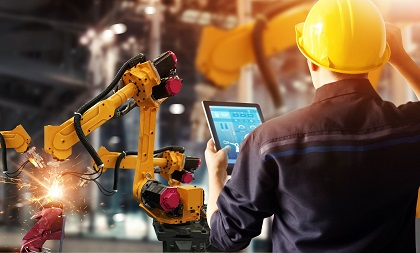
“Few areas of industrial endeavor are untouched by digitalization...engineering innovation - whether it’s destined for the high seas, the operating theatre or the farmer’s field - is increasingly reliant on the intelligent use of data,” he wrote.
“And, as we look further ahead, the degree to which this drives different sectors to collaborate and learn from each other will surely become one of the defining characteristics of modern engineering.”
To get ahead of the ever-expanding automation industry, the Engineering Institute of Technology (EIT) delivers industrial automation programs to students around the globe via a unique online methodology. It makes use of live and interactive tutorials, an international pool of expert lecturers, dedicated learning support officers, and state-of-the-art technologies such as hands-on workshops, remote laboratories, and simulation software.
The supportive blended learning model and small class sizes encourage students to advance their technical knowledge and remain engaged in their studies while forming global networks and balancing life and work commitments.
Students can also apply to study applicable degrees in Australia at their campuses in Perth and Melbourne.
A new cohort of industrial automation students are set to familiarize themselves with the Internet of Things and other technologies that are automatizing the workplaces of the future, thanks to EIT.
EIT also offers short-courses that provide working technologists and engineers with professional development opportunities. These courses all have a specific focus and are designed to help engineers upskill and cross-skill to keep their knowledge relevant as technologies continue to develop and change the nature of their work.
For instance, practitioners working in the industry can opt to do the three-month-long Professional Certificate of Competency in Industrial Data Communications to continue to grow their proficiencies with the kinds of technologies that are embodying the fourth industrial revolution. EIT hosts many other professional development courses, including: ‘Practical Machine Learning using Python for Engineers and Technicians’ and ‘Programmable Logic Controllers (PLCs) & SCADA Systems.’
A technology significantly propped up by the automated systems defining the fourth industrial revolution is industrial robotics.
Robots: From China to the rest of the world
China is a country that is seeing a significant uptake of industrial robotics. The International Federation of Robotics back in 2016 were predicting big things for the year we currently find ourselves in.
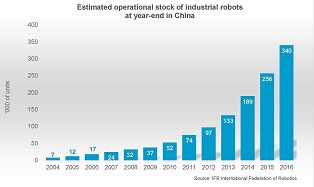
They wrote, “China has rapidly become a global leader in automation. From 2018 to 2020, a sales increase between 15 and 20 percent on average per year is possible for industrial robots... China intends to forge ahead and make it into the world’s top 10 most intensively automated nations by 2020. By then, it’s robot density is targeted to rise to 150 units - this being the number of industrial robots per 10,000 employees.”
A report by the Wuhan University of Quality Development Strategy predicts that if China’s goals are met, by 2025, automation will replace at least 5% of the Chinese workforce. The report purportedly surveyed 2,000 companies in China. This trend is expected to be observed at varying levels globally.
The onus is thus on students to grow their skill sets, and pepper their careers with creative and entrepreneurial endeavors within their industry. This will ensure that they stay ahead of the curve as automation replaces the repetitive tasks of the past. The advent of automation was also never intended for the mass-replacement of workers. It is being spearheaded to open up new avenues for workers to do much more meaningful work.
Nonetheless, the need for skills development still stands. Companies have a new responsibility to keep workers skilled, but workers too are expected to keep on developing themselves as the job markets change around automation. Will you rise to the automation challenge in 2020?
Works Cited
“BACK ISSUES |.” The Engineer, www.theengineer.co.uk/back-issues/.
Papadopoulos, Loukia. “By 2025 Nearly 5% of China's Workforce Will Be Replaced by Robots, Reveals New Survey.” Interesting Engineering, Interesting Engineering, 23 Dec. 2019, interestingengineering.com/by-2025-nearly-5-of-chinas-workforce-will-be-replaced-by-robots-reveals-new-survey.
- Details
- Written by: Quintus Potgieter
Tesla has officially announced that its lithium-ion home batteries, named the Powerwall, will be available in South Africa in 2020.
They have sent surveys to prospective South African customers inquiring about their home energy usage.
The questions the company put to the eager respondents were:
- Do you have a Solar PV system currently installed at this property?
- Do you own this property?
- When would you like the installation to occur? (Within six months or 6-12 months)
- Why do you want to install Powerwall or Solar Panels?

Tesla will send this feedback to a Certified Third Party Installer company who will make contact with the customer. This means there are companies with electrical engineers in South Africa, who are ready to install the solar panel arrays and the Powerwall.
Therefore, future electrical engineers in South Africa should be learning the tools of the renewables trade so that they, too, can find employment in the industry as it is set to blossom.
The consumer solar photovoltaic industry has been stymied for quite some time in South Africa. However, due to ongoing electricity load shedding in the country by the state utility, renewable energy is gaining in popularity.
According to My Broadband, a company named Rubicon is one of the companies importing the Powerwall to South Africa. They confirmed the pricing for South Africans to be:
- Powerwall: R120,000 (USD $8,203.92)
- Backup Gateway: R19,900 (USD $1,360.46)
- Installation cost: R10,000 to R15,000 (USD $683.65 to USD $1,025.48)
Those in rural areas of South Africa can expect to pay significantly more in installation costs. Nonetheless, the availability of the Powerwalls to metropolitan areas in South Africa is a positive step in the right direction for a country urgently seeking to create and store electricity, powered by the African sun.
Powerwall 2, the second iteration of the Powerwall technology, can provide a consumer 13.5kWh of stored energy ready to use. It is a fully integrated AC battery system for residential or light commercial use.
To solve South Africa’s energy crisis, however, more solar companies are having to throw their hats in the ring. Lamo Solar has highly impressed the President of South Africa, Cyril Ramaphosa. The President, at a recent investment conference, acknowledged the work the solar company is doing and encouraged more small and medium-sized enterprises to enter the renewable energy space.
South Africa is looking for innovative solutions to bringing electricity to the masses in 2020, as the government figures out what to do with the ailing state utility. President Ramaphosa has indicated that he wants to attract the likes of Elon Musk to South Africa so they can bring with them their innovative engineering technologies.
With the changing landscape of electrical engineering, engineers must continue learning and developing their skills.
The Engineering Institute of Technology (EIT) is one of the only institutes in the world specializing in engineering. Through our unique online delivery model, students can study with us from anywhere in the world, to continue their education while maintaining work and family commitments.
EIT offers several electrical engineering programs at different levels, from professional development, through to vocational education and training, and higher education.
Works Cited
Musk, Elon. “Would Love to, but Import Duties Are Extremely High, Even for Electric Vehicles.” Twitter, Twitter, 28 Aug. 2019, twitter.com/elonmusk/status/1166854343770988544?ref_src=twsrc^tfw|twcamp^tweetembed|twterm^1166854343770988544&ref_url=https://businesstech.co.za/news/technology/338275/elon-musk-on-why-tesla-is-not-in-south-africa/.
Vermeulen, Jan. “Tesla Powerwall Is Back in South Africa.” MyBroadband, 2 Dec. 2019, mybroadband.co.za/news/energy/328955-tesla-powerwall-is-back-in-south-africa.html.
- Details
- Written by: Quintus Potgieter
Air travel is a major contributor to CO2 emissions and is attracting the ire of environmentalist movements who are campaigning for the industry to look to alternative methods of powering aircraft.
Airbus is looking to nature for inspiration to minimize the carbon footprint their planes create around the world. They are suggesting that planes could fly in V-shape formations — as seen by geese migrations in the animal kingdom — to save fuel and lower emissions.

In the first six months of 2020, Airbus hopes to test the flying formations with two A320 planes. The planes will fly a predetermined route in a configuration that will test the aircraft’s ability to utilize what is known as ‘wake energy retrieval.’
On their website, Airbus writes, “Just like birds, every aircraft creates a wake while flying. Flying together could thus help aircraft to retrieve the lost kinetic energy by positioning a follower aircraft in the air upwash of one of the lead aircraft wakes. Airbus is taking a fresh look at how this flight technique could provide aircraft with free lift, enabling them to reduce engine thrust and fuel consumption.”
Airbus says that air traffic management technology has experienced a leap forward. Historically, the air traffic management tech would have been unable to aptly monitor two planes flying so close together, but Airbus says the technology is now more than capable. The flight engineers at Airbus will be engineering around the idea and demonstrating the company’s proficiency, under a project named Fello’fly.
Airbus says that by flying planes 3km apart from each other, the aircraft can benefit from the wake retrieval energy, which can equate to 5 to 10% less fuel and emissions. The prohibitive factor that could delay this innovative step is collaboration across the industry as a whole. Getting all aircraft companies coordinated and collaborating could be tough.
Nick Macdonald, Fello’fly Demonstrator Leader in a press release, said, “To achieve this evolutionary step in operations, we have to look at the challenge from the perspective of all industry stakeholders. It’s a great opportunity for our industry to demonstrate a joint commitment to reducing our use of fossil fuels.”
Hydrogen-powered aircraft coming soon?
The aviation engineering industry has been around long enough for it to, in a way, return to its roots. Now with the means to meet the zero carbon propulsion vision of the future, the industry is considering a shift back to hydrogen as a potential fuel source.
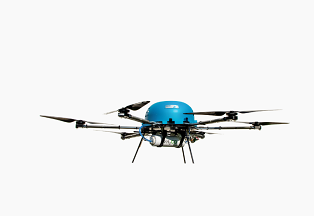
An engineering team at Imperial College in London has patented a hydrogen storage solution they believe could be implemented in the air travel industry. They are calling it H2Go Power.
Co-Founder and Director of H2Go Power, Dr. Enass Abo-Hamed, initially began work on the technology at the department of chemistry at the University of Cambridge.
“We have developed through the past two years a safe method for hydrogen production and storage for providing power on the movie. Our core technology involves a novel porous catalytic material, which produces, stores and releases hydrogen in a controlled manner. Our unique solution allows for the deployment of Fuel Cells into new markets, such as portable consumer electronics. The potential outcomes include smartphones that last 5x longer than ones that have current battery technology and all-electric vehicles with the same range as combustion engine counterpart.”
The company has subsequently begun working on powering drones with hydrogen fuel cells. The company’s systems work by converting the hydrogen gas into a solid-state, which makes storing the gas that much safer. It is stored in a specially designed 3D-printed tank. Inside the tank are a network of aluminium tubes.
Through one side of the reactor Hydrogen (H2) is pumped through a catalyst, freeing electrons and, in turn, generating the electricity. On the other side, oxygen (O) is pumped in and fuses with the positively-charged hydrogen atoms. The only emission that the process creates is water.
The UK government and the EU are injecting money into the company to continue to develop the fuel cells. Dr. Enass Abo-Hamed said:
“While it takes hours to recharge a lithium-ion battery-powered drone, it could take minutes to do that with hydrogen. Maybe in the next 20 or 30 years, we could even start thinking about how to put this in commercial flights and decarbonize air travel — which is very important for our climate.”
Works Cited
Airbus. “Airlines Are Looking to Reduce Fuel Consumption. Wake-Energy Retrieval Could Help.” Airbus, Airbus, 18 Nov. 2019, www.airbus.com/newsroom/stories/airlines-are-looking-to-reduce-fuel-consumption-wake-energy-retrieval-could-help.html.
“Pioneering Clean Tech. Delivering Safe and Reliable Power Supply for All.” H2GO Power, www.h2gopower.com/.
- Details
- Written by: Quintus Potgieter
It is no exaggeration to say that technology has taken a giant leap forward in the last decade.
In this decade, Uber revolutionized taxi industries around the globe, 4G networks brought fast internet to the masses, and Whatsapp and Instagram appeared on the world stage.
Who do we have to thank for these incredible contributions to daily life? Engineers, in part.

The arrival of those advents of technology proves that the next decade could be equally as disruptive in the world of engineering. These technologies have sent the dominoes falling in the industry, revolutionizing how we all do business, mobility, learning, networking, and automating.
Naturally, engineers are philosophizing of what could be the next big thing that transforms industry across the world.
Artificial intelligence and self-driving cars are the buzzwords flying around at the moment. However, we could ask: What other engineering innovations could be hiding in plain sight, just waiting for a business plan to set them in motion?
The most recent addition of the Fourth Industrial Revolution is 5G networks — which have speed capabilities set to make the work that both humans and machines do more efficient. 5G mobile internet speeds range from about 50Mbit/s to over a gigabit. It is now leading to the development of smart cities by increasing the rate of interconnectivity.
The speed of 5G is making virtual and augmented reality simulation technologies a physical reality.
The development around simulation technologies and the transformations of the online and on-campus training industry is what the Engineering Institute of Technology is interested in monitoring.
Extended reality
Extended reality can be loosely described as the development of immersive technologies that combine both physical and virtual worlds. Experts expect that the next decade of technological development will create incredible opportunities in the extended reality space.
Immersive experiences have the unique ability to teach. This way, extended reality systems could train the world’s future engineers. Through a smartphone, glasses, or tablet, augmented reality systems can display virtual information and images on top of the real world.
Augmented realities can help engineers display machinery on a factory floor before it has even been purchased or installed, to determine what the end product might look like. It could also simulate end products in the real world when the product has not been manufactured yet.
In virtual reality, engineers can see the inside of a building or bridge construction where, in the real world, a brick or piece of steel has not yet been laid. The virtual reality world is a world entirely made up of computer-generated graphics. It can be used to simulate technologies engineers may see in the field, and help engineers learn how to operate integral machinery before doing the job in the area. It gives the engineer a 360-degree view of a simulated environment. The training and learning opportunities with this technology are innumerable.
Mixed reality is where the worlds of augmented and virtual reality come together. Microsoft’s head-mounted Hololens integrates 3D virtual elements and superimposes them into and all around the real world.
One of the bigger players in the extended reality space is American multinational semiconductor and telecommunications equipment company Qualcomm. In December 2019, the company announced the launch of its XR2 platform. They are calling it the ‘world’s first 5G-supported extended reality (XR) platform’, running off their specially designed Snapdragon chipsets.
The company is collaborating with Niantic Labs, who brought the world Pokemon Go and, more recently, Harry Potter: Wizards Unite. On their announcement of the collaboration with Qualcomm, they write:
“At Niantic, we’re unlocking the potential to create next generation AR experiences through the Niantic Real World Platform, and building new ways to map, share entirely and understand reality. The Niantic Real-World platform has been proven out by hundreds of millions of users…”
The Engineering Institute of Technology will continue to monitor the development of these extended reality technologies. The future of education and training with the 5G internet speeds — and technologies that can make the most of those speeds, like extended reality applications — is generating immense opportunity to continue training and educating engineers who, in turn, create a better world for all humankind.
What do you think the next technological leap forward will be?
- Details
- Written by: Quintus Potgieter
Starting from 2020, 4 March will now be the World Engineering Day for Sustainable Development as designated by the World Federation of Engineering Organizations (WFEO). Previously known as ‘Engineer’s Day’, the celebration was formerly observed in several counties on various dates throughout the year.
The announcement was made on November 20th at the 2019 World Engineers Convention by WFEO President, Dr Marlene Kanga.
The WFEO is one of the biggest engineering collectives in the world, bringing together national engineering organizations from over 90 nations and represents around 20 million engineers worldwide. The federation was founded on March 4th 1968, making the new date for World Engineering Day an obvious choice.

The resolution to get the day officially recognized as the World Engineering Day for Sustainable Development was adopted at the 206th UNESCO Executive Board session. It was decided on that day in April to set the announcement for the World Engineers Convention of 2019.
The WFEO has also defined the main topics the day will aim to recognize and celebrate. The goals of World Engineering Day have been outlined as:
- To demonstrate the role of engineers and engineering
- To develop solutions to climate change.
- To raise the profile of engineering and technology, and its role in improving the quality of life worldwide, and achieving the UN Sustainable Development Goals.
- To encourage dialogue between engineers and decision makers, industry leaders, scientists, non-governmental organizations and the public at large on issues relating to climate change and sustainable development.
- To enable policies and solutions to address the world’s most pressing problems using engineering and improve dialogue between citizens, engineers and policy-makers.
- To encourage, more young people, especially girls, to consider engineering as a career.
“Engineers are often not very good at articulating the value of what we do for society. That’s a problem, because engineering is critical to achieving the UN Sustainable Development Goals” said Dr Kanga, during her opening address at the World Engineers Convention.
“As we all face the impacts of climate change, environmental crises, our growing cities like artificial intelligence, we’re going to need more engineers.”
It was particularly developing countries that were pushing forward hard for the 4th of March to be recognized worldwide. UNESCO representatives from the Republic of Namibia were instrumental in putting together documentation that was used to introduce the motion to recognize World Engineering Day to the board.
Ambassador Albert Aochamub, Namibia’s permanent delegate to UNESCO’s 296th executive board meeting, introduced the resolution. The country believes that engineers play a pivotal role in a nation that needs engineering solutions to infrastructural and societal problems. Other countries that considerably supported the motion were China, Nigeria, France and the United Kingdom.
The World Engineering Day for Sustainable Development is part of UNESCO and WFEO’s engineering goals for 2030. The focus is to bring more people into engineering education and develop engineering solutions for countries to breed nation building. For the life changing work engineers do in a calendar year, now they can wake on the 4th of March knowing that their work is valued and that they are an integral piece to the puzzle of their societies wherever they are placed.
Works Cited
“From next Year, the World Will Finally Have a Day to Celebrate Engineering.” Create, 20 Nov. 2019, www.createdigital.org.au/world-day-celebrate-engineering/.
“World Engineering Day for Sustainable Development.” WFEO, www.wfeo.org/world-engineering-day-for-sustainable-development/.
- Details
- Written by: Quintus Potgieter
Engineers at the University of Rochester in New York are working to develop “unsinkable” materials. Once perfected, these metals could be used to build unsinkable ships, create puncture-proof life jackets, and protect electronics from water damage.
The work is being conducted in the Femtosecond Laser Laboratory at the university. The researchers have been making metals superhydrophobic by utilizing femtosecond lasers.
Femtosecond lasers are traditionally used in cataract surgery. The laser is used to cut patterns into a surface at the nanoscale — in this case, into a metallic structure. The result is a surface that can trap air bubbles.
The researchers put together two aluminum plates facing inward with just enough space in between them to trap the minimum amount of air needed to float. But that’s only half the battle.

Trapping air bubbles is only a short term solution, and after a while, the structure will sink. Researchers have been looking for a way to enable the metals to float for prolonged periods.
The researchers have now turned to nature for inspiration, and have been studying argyroneta aquatic spiders and fire ants. The spiders spin underwater dome-shaped webs that they fill with air using their legs and abdomens. Fire ants band together with their superhydrophobic bodies to create a ‘raft’ that floats above the water.
The work is spearheaded by Professor Chunlei Guo, a professor of optics and physics at the University of Rochester. The researchers published a report in ACS Applied Materials & Interfaces. They report that even when damaged, the pattern-etched metal can continue to float:
“The assembly shows an unprecedented floating ability; it can float back to surface even after being forced submerging underwater for months. More strikingly, the assembly maintains its floating ability even after severe damage and piercing in stark contrast to conventional watercraft and aquatic devices. The potential use of the SH floating metallic assembly ranges from floating devices and electronic equipment protection to highly floatable ships and vessels.”
The space in between the aluminum plates creates a watertight compartment. Along with the air-trapping laser-etched pattern, the result is a superhydrophobic metal - meaning it repels any liquid that touches it. The effect created is quite something to behold, as can be seen in this video:
This work could have some incredible consequences for engineering industries in the future. The researchers conducted a test where they forced their metal underwater for two months in perpetuity. After two months they planned to release the weight atop the metal to see if the metal would sink, but to their surprise, the metal was as buoyant as ever.
Works Cited
“Highly Floatable Superhydrophobic Metallic Assembly for Aquatic Applications.” ACS Applied Materials & Interfaces, pubs.acs.org/doi/10.1021/acsami.9b15540.
Linder, Courtney. “Unsinkable Metal Could Lead to Unsinkable Ships. Now Where Have We Heard That Before?” Popular Mechanics, Popular Mechanics, 7 Nov. 2019, www.popularmechanics.com/technology/design/a29724303/unsinkable-metal-ships/.
- Details
- Written by: Quintus Potgieter
Imagineer.
Verb.
Gerund or present participle: Imagineering
Devise and implement a new or highly imaginative concept or technology.
How do engineers instill a feeling of magic in people’s minds? Some have spent the last 70-years creating innovations that stir up a sense of awe and wonder in anyone who experiences Disney – its theme park has even been dubbed the happiest place on earth.
These engineers have been working creatively in a space that has been described as equal parts design studio, design center, think-tank, and innovation laboratory. This laboratory of innovation is known as Walt Disney’s Imagineering. And the engineers that work there are called Imagineers.
These Imagineers are the fascinating individuals behind the scenes at Disney who invent and design the magical feats that have cemented Disney as one of the greatest entertainment brands in the world.

And the world has never really heard their story, until now. In November, Disney released their streaming video service Disney+, with a documentary on the Imaginers entitled: The Imagineering Story.
The documentary begins by telling the Disney story from 1928 but quickly shifts focus on the building of the first Disneyland in California, which opened in 1955. Bob Iger, the current CEO of Disney, said, “Walt set a standard early on with the Imagineers.
“There was a standard that surprised people, a standard that enabled people to come in expecting something and giving them something even beyond that. Beyond, really, their own imagination. So that they left thinking, ‘wow, either only Disney could do that,’ or asking, ‘how did Disney do that’”.
The inspiration for Disneyland came from Walt Disney’s daughter. Walt took notice of the things his daughter enjoyed as a child and wanted to create a place where parents and their children could have fun together.
The first bit of engineering involved building a model railroad and train in his backyard. From there, he became obsessed with the idea of creating a theme park.
In 1952, Walt Disney formed a group named WED (Walter Elias Disney) Enterprises Inc. to design and build on the growing idea of Disneyland. He recruited creative staff already working for animation divisions within Disney and found other designers to be the first Imagineers.
Walt Disney dared this first intake of Imagineers to bring the abstract notion of Disneyland and turn it into a three-dimensional reality.
Creativity in engineering
Disney purchased land in Anaheim, California, and began seeking funding to build Disneyland. Amusement parks at the time were not raking in business in America. Nonetheless, the construction of the first Disneyland commenced in 1954.
Bob Gurr, an Imagineer and Industrial Designer who worked for Disney from 1955-1991 described the atmosphere of that first stage of construction. “The concept of ‘creative chaos’ is a word that you hear a lot of times, and I just thought it was an absolute marvel of super-organization without being organized. We were able to move so fast; we built it before the Xerox machine was invented. ”
The combination of skills, expertise, and innovation from many different creative individuals formed part of a genuinely innovative engineering team. Those who were involved with the project say that in today’s world, you would find hard-pressed to find an engineering team similar to that of the Imagineers who worked on the first Disneyland.
After blazing through US$17 million — triple the amount of money they planned on spending —the first Disneyland opened its doors on 17 July 1955. Two months later, the one-millionth visitor would walk through the doors. It was a roaring success, and a new era of theme parks had been born. Soon after, Disney began focusing on adding rollercoasters to the theme park. By July 1959, The Matterhorn Bobsleds, the first tubular steel roller coaster in the world, was opened.
More and more innovations would be added to Disneyland through the years as technology advanced. But what they achieved back in the 50s is nothing short of incredible.
However, Disney is not slowing down. They continue to build new attractions at their theme parks and utilize technology to thrill customers. Walt Disney famously said, “Disneyland will never be completed. It will continue to grow as long as there is imagination left in the world. It is something that will never be finished.”
The ideological position on engineering that Disney, as a company, employ, can inspire all other engineers. Creating innovative technologies, and utilizing imagination is something that can break the sometimes tedious engineering process. Creating a unique environment for invention with an atmosphere of childlike imagination is what Disney has thrived on in all the facets of their company. Disney along with the Khan Academy, has also put together a free course that can give you the basics of becoming an Imagineer. You can access it here:
https://www.khanacademy.org/humanities/hass-storytelling/imagineering-in-a-box
Works Cited
Disney, www.disneyplus.com/en-gb/video/a250e541-a085-4b1f-aced-631a2cf88501.
- Details
- Written by: Quintus Potgieter
Engineering companies in the United Kingdom are ensuring the engineers of the future engage with engineering through collaboration and innovation. To achieve this, the Royal Academy of Engineering has developed a day to celebrate engineers and their contribution to the world. The day is aptly named: This Is Engineering Day, and it took place on Wednesday, the 6th of November.
“From the shoes you wear and the phone in your hand, through to the music you listen to and the games you play, engineering is at the heart of everything. It brings ideas to life and turns dreams into reality. Whether you’re into sports, beats, fashion, festivals, trainers, or tech, there’s a place in engineering for you.”
On the same day the fourth iteration of the Engineer magazine’s 2019 Collaborate to Innovate (C2I) awards took place, recognizing some of the most awe-inspiring UK-led engineering projects from the past year.

Neil McDougall, Managing Director of Frazer-Nash Consultancy writes in C2I’s report, “This century will bring advances in technology, equipment, and systems that we can’t yet imagine, but, for the present, our profession is being held back by a lack of entrants wanting to join its ranks.
“The skills shortage in engineering is, of course, well recognized: the government has predicted a shortfall of around 186,000 engineers each year until 2024. But, even by 2024, the range of expertise needed by many engineers will have changed.”
Winning projects
Collaborate to Innovate’s initiative awards engineering innovation in these categories:
- Aerospace, Defence & Security
- Automotive
- Energy & Environment
- Healthcare & Medical
- Information, Data & Connectivity
- Manufacturing Technology
You can read up on all of the winning projects by clicking here.
The winning project for the Information, Data & Connectivity category involved a technological setup that could alert engineers of the structural integrity of bridges in danger of collapsing. The project was developed by a startup company from the University of Nottingham in conjunction with Leica Geosystems, Geomatic Ventures Limited, and China Railway Major Bridge Reconnaissance & Design Institute (BRDI).
In C2I’s report, they explained how their GeoSHM system works, “GeoSHM (GNSS and Earth Observation for Structural Health Monitoring) uses multiple space technologies combined with in-situ sensors to provide a real-time picture of bridge movement and stresses.
“At the core of the system are GNSS (Global Navigation Satellite System) receivers that pick up positional data via the GPS, Galileo, and BeiDou Navigation Satellite (BDS) constellations. This real-time monitoring is complemented by interferometric synthetic-aperture radar (InSAR) data provided by Earth Observations (EO) satellites that can track potential ground subsidence of the structure”.
The companies worked on the project with the Ponte Morandi bridge collapse (that occurred in Genoa, Italy in 2018) in mind - an unexpected failure that led to 43 fatalities. The bridge-monitoring technology has been in development for the last 15 years, but it is the collaboration between companies cross-continent that is unlocking the potential of the technology and finally getting it to market.
Professor Xiaolin Meng, director of Nottingham University’s Sino-UK Geospatial Engineering Center told the Engineer magazine, “By collaborating with BRDI and providing our expertise in earth observation and monitoring technologies, we can help improve the way that bridges are constructed.
“The wide-reaching range of geospatial data that we are able to provide through our research work also has massive potential in helping to develop smart transport management solutions within the big cities in the UK and China.”
The engineers are putting together a data strategy for their project, which will culminate in the creation of a database that will help structural engineers on a specific bridge understand how environmental conditions are impacting the structural integrity of their bridge. The collaborative effort with all of the engineers bringing their own expertise to the project has turned the technology into a multifaceted system that could help secure bridges in the future. The projects recognized at the C2I Awards show that collaboration is the key to innovation, instead of the political isolationism the world is currently seeing.
Works Cited
Excell, Jon. “Collaborate to Innovate 2019 Winners Announced.” The Engineer, 7 Nov. 2019, www.theengineer.co.uk/c2i2019-winners-announced/.
“This Is Engineering: Home.” ..., www.thisisengineering.org.uk/.
- Details
- Written by: Quintus Potgieter
Technology is rapidly transforming the world of work. Traditional curricula in tertiary education institutions must change with the times to better prepare graduates for the technologies they will need to utilize once they enter the workforce. Likewise, students are wondering what roles they might have post-graduation, as the job landscape is continually evolving with automation.
Australia’s Institute Centre for Future Work agrees that students might enter roles that their degrees have not prepared them for. They conduct economic research on work, employment, and labor markets, and believe that educational institutions need to begin evolving their offerings to cater to the skills of the future within the majority of industries.

“Individuals with university degrees are more likely to be employed, to have more stable jobs, and to be paid more,” they stated in their report.
“But this relative advantage enjoyed by university graduates does not negate the fact that employment conditions have become much more challenging even for graduates. Rates of graduate employment in full-time work are down significantly over the past decade, and there is evidence of a growing mismatch and underutilization of university graduates in positions that do not fully or even partly utilize their hard-won knowledge and skills.”
Prospective engineers are, therefore, being encouraged to step out into cross-disciplinary avenues of the engineering world to make themselves as attractive to the workforce as possible. As a result, recent graduate engineers report that obtaining first-time employment has been swift.
Quality Indicators for Learning and Teaching (QUILT) provides prospective students with relevant and transparent information about Australian higher education institutions from the perspective of recent students and graduates. They reported in 2016 that 83.1% of engineering graduates found work in the first four months after graduation.
In 2017, QILT conducted further research and found that engineering graduates were the highest in demand in STEM (science, technology, engineering, and mathematics) industries. They found that 79% percent of engineering graduates surveyed had successfully found full-time employment.
Worryingly, in Australia, the sciences (natural, physical, biological, and medical) had the highest number of graduates but had the lowest percentage of graduates in full-time work at only 57%.
Australia Institute’s Center for Future Work says that in their findings, generalist degrees are becoming less useful in the world of work in the future. They do note, however, that the literacy skills attained from those kinds of courses are beneficial in a world of engineering expansion where smart machines and artificial intelligence are replacing menial tasks, and demanding more creative output from the employee.
“In an age of disruption and growing demand for critical, abstract and human-led inquiry, the knowledge acquired through university degrees will be crucial to the future economy,” they state.
“In Australia, degrees have an enduring and growing importance as job market entry qualifications; 32% of all jobs worked in May 2018 required a bachelor’s degree or higher qualification, and this share is projected to increase by one percentage point to 33% of all jobs by 2023.”
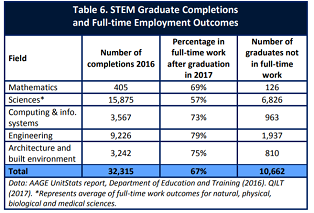
Globalization and digitization are warping the industries of education and training, and the world of work. The Engineering Institute of Technology’s programs are designed by an international body of industry experts, ensuring students graduate with cutting-edge skills that are valued by employers around the world. The program content remains current with rapidly changing technology to best prepare students for the workplace.
We offer industry-focused short courses and accredited diplomas, bachelor’s, and master’s degrees related to specific engineering fields, one of which is industrial automation. Our industrial automation programs marry electrical engineering with mechanical engineering and aim to prepare students for the jobs of the future.
Our short courses, called Professional Certificates of Competency, are designed to upskill engineers who already work within the industry. We provide professional development in specific areas, so they can further enhance their skills and continuing learning throughout their careers.
Our diplomas and advanced diplomas are vocational programs that deliver practical knowledge and aim to enhance the skills of people who come from a trade background and want to progress their career. Our degrees are designed to give our students both theoretical and practical knowledge required to enter the engineering world. Like all Australian higher education providers and universities, EIT programs are accredited by the exacting standards of the Australian Government’s Tertiary Education Quality and Standards Agency (TEQSA). Many of our degrees are recognized under international engineering accords.
Our unique online delivery model is designed to allow students to study from anywhere in the world while balancing life and work commitments. It makes use of live and interactive tutorials, an international pool of expert lecturers, dedicated learning support officers, and state-of-the-art technologies such as hands-on workshops, remote laboratories, and simulation software. Our supportive blended learning model and small class sizes encourage our students to advance their technical knowledge and remain engaged in their studies while forming global networks
Future and current engineers can be confident in the fact that the industry will continue to grow, but they must also be cognizant that they might end up a field they were never expecting to be in. That reality is beginning to define the future of work.
Works Cited
Pennington, Alison, and Jim Stanford. “The Future of Work for Australian Graduates.” APO, Centre for Future Work, 22 Oct. 2019, apo.org.au/node/264441?utm_source=APO-feed&utm_medium=RSS&utm_campaign=rss-research.
Winsor, John. “The Future Of Work Will Be Uniquely Human.” Forbes, Forbes Magazine, 23 Oct. 2019, www.forbes.com/sites/johnwinsor/2019/10/21/the-future-of-work-will-be-uniquely-human/#73a1a96416b7.
“The University Degrees You SHOULDN'T Be Doing If You Want to Get a Job in Australia after Graduation.” Daily Mail Online, Associated Newspapers, 22 Oct. 2019, www.dailymail.co.uk/news/article-7600247/The-university-degrees-SHOULDNT-doing-want-job-Australia-graduation.html.
- Details
- Written by: Quintus Potgieter
On a Tuesday morning in late October, Danish engineers engaged in a risky and costly rescue operation to move one of Denmark’s most beloved landmarks. The Rubjerg Knude Fyr lighthouse was first lit in 1900 and is the Danish north coast’s jewel and a national treasure. However, due to coastal erosion, engineers have said the tourist attraction needed to be relocated.
The 76-foot tall lighthouse was 656 feet away from the coast when first lit in 1900. Each year, the sand dune has been eroding by approximately two meters. Before the relocation, the lighthouse was just 20 feet away from plummeting into the ocean.
As a consequence, the local government contracted local engineers to try and save the structure.
Engineers drew up plans to move the 720-tonne lighthouse in a way that would not compromise its structural integrity. The idea was to move the structure 70 feet away from its original position.

The mayor of the Hjorring Municipality said that many things could go wrong when moving the now unmanned lighthouse, but deemed it a risk worth taking.
The lighthouse was switched off in 1968, and soon after, it was converted into a museum documenting the effects of sand drift. Still, the tower reportedly attracts up to 250,000 people per year.
It is positioned on a gigantic sand dune on the western island of Jutland, atop a cliff that is 200 feet above sea level. A church building has already been deconstructed due to coastal erosion in the same region.
Engineers, however, did not think dismantling the lighthouse would be the best way forward. Therefore, they decided that the building would have to be moved atop a set of rails. They inserted the beams into the base of the structure and lifted it. They kept it lifted atop of the tracks and moved it along with the help of hydraulic jacks.
The engineers expected the move to last ten hours because they could only move 26 feet per hour. However, the process went much faster. The engineers initially thought the lighthouse would weigh 1,000 tonnes and be harder to move, but once they began work they found out it only weighed 720 tonnes.
“We could not go faster than 12 meters an hour because they needed to calibrate the hydraulics. It’s in sand and you need to ensure it runs well on two rails,” local builder Kjeld Petersen, who assisted the engineers in the lighthouse operation told the BBC.
The lighthouse move cost the local government only US $750,000. The move had been planned for a year and a half, and the entire prepping and relocation took ten weeks. The engineers are confident that the lighthouse should not be in too much danger due to erosion for the next forty years.
Works Cited
Associated Press. “Danish Workers Moved a 120-Year-Old Lighthouse before It Could Topple over the Side of a Sand Dune Cliff.” Insider, Insider, 22 Oct. 2019, www.insider.com/denmark-moves-120-year-old-lighthouse-because-of-erosion-2019-10.
“Danish Rubjerg Lighthouse Moved Inland on Skates.” BBC News, BBC, 22 Oct. 2019, www.bbc.com/news/world-europe-50139900?ocid=socialflow_twitter.
- Details
- Written by: Quintus Potgieter
Could climate change prediction models and regional data collected by cities help ensure the safety of infrastructure in the future? Securing infrastructure like bridges and making them weatherproof is pretty important work. However, with more extreme weather events predicted for the future, how can engineers be sure their bridges will stay standing?
Engineers have life-cycle projections for bridges they have constructed. Although in a world threatened by more fierce climate events, the life cycle of bridges could be under threat. Predictive and preventative maintenance on bridges could be done in a much more informed manner if engineers were aware of future climate events and how those events could damage the structural integrity of bridges.
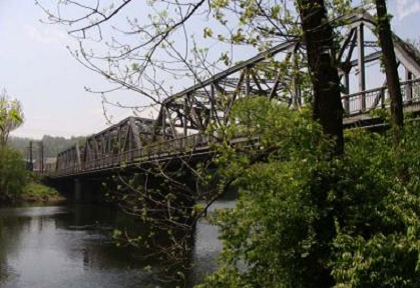
A less predictable threat to the structural integrity of bridges is scour. Scour is the erosion of soil around the foundation of a bridge caused by fast-moving water underneath it —typically during floods.
Scour is the most significant contributing factor to bridge failure in the United States. According to Ayres Associates, 82% of the 600,000 bridges in the National Bridge Inventory in the United States are built over waterways. With more and more climate events occurring globally, the likelihood of flooding, and in turn, scour increases.
As a consequence, engineering bodies are looking to academia to assess the impact of climate change on bridge safety. Lehigh University, a private research university in Pennsylvania, has put researchers David Yang and Dan M. Frangopol on the case.
The two researchers have published a paper in the ASCE Journal of Bridge Engineering under the title: ‘Physics-Based Assessment of Climate Change Impact on Long-Term Regional Bridge Scour Risk Using Hydrological Modeling: Application to Lehigh River Watershed.’
Research associate in civil and environmental engineering at P.C. Rossin College of Engineering and Applied Science, and co-author of the report, David Yang, said, “We know climate change will increase the frequency and intensity of natural hazards like hurricanes, heatwaves, wildfires, and extreme rains.
“For this paper, we’re looking at increased temperature as well as increased precipitation and their impact on bridge safety. The challenge here was that we didn’t know how to quantify those impacts to predict scour risk.”
Therefore, the researchers looked to climate data to see if they could produce a predictable model for structural safety in the face of climate events.
“We took a holistic approach. It started with a global climate model that was downscaled to regional hydrology. Then we used structural engineering to get the failure probability of a structure in a future flooding event,” Yang explained.
“From that, we could assess: does this structure failure pose certain risks to a community? So our model included these four steps of climatology, hydrology, structural engineering, and risk assessment.”
They conducted research and developed their own model by using flow discharge measurements in their local river, the Lehigh. They inserted global climate models as developed by the Intergovernmental Panel on Climate Change (IPCC), and added historical bridge foundation depth data in their local river, provided by the National Bridge Inventory. What they found was that flooding was becoming more common, and doubling in frequency as time went on.
The question now is how to export this model for other regions and make it useful for the engineering industry as a whole. Engineers will be better equipped to mitigate risk and plan for disaster far better than in the past with these kinds of models.
“You need to know the location of the bridge. For some communities, the failure of a bridge could be disastrous. For others, a bridge may not be as critical,” Dan M. Frangopol, an affiliate of Lehigh’s Institute for Data, Intelligent Systems, and Computation (I-DISC) said.
“This model helps you make that kind of decision because risk is not only based on safety but also on the consequence of failure. You might have two bridges at the same probability of failure, but the consequences of that failure could be very different.”
Civil and structural engineers can be sure that there will be more data-driven mechanisms that challenge their safety checks and balances in the future. With historic trends and future prediction models combined, there will be no running away from establishing meticulous safety procedures on bridges (their foundations in particular) and other infrastructure.
Works Cited
“Predicting the Impact of Climate Change on Bridge Safety.” ScienceDaily, ScienceDaily, 9 Oct. 2019, www.sciencedaily.com/releases/2019/10/191009075326.htm.
“What Is Bridge Scour? Why Should You Care?” Ayres Associates, 13 Sept. 2018, www.ayresassociates.com/bridge-scour-care/.
- Details
- Written by: Elyse Simich
It was the curse of the commentator. Deloitte Risk Advisory Africa had just released a report on the lack of organizations’ preparedness for cybersecurity attacks in Africa. Soon after, hackers attacked the government of the City of Johannesburg in South Africa.
On the 25th of October 2019, employees of the City of Johannesburg found the following message displayed on their terminals:
“All your servers and data have been hacked. We have dozens of back doors inside your city. We have control of everything in your city. We also compromised all passwords and sensitive data, such as finance and personal population information.”
The hackers asked for a ransom of 4.0 Bitcoins, which would amount to US$30,392. They threatened that if the city did not pay it by the 28th of October, that they would upload all of the data onto the internet. In July 2019, the City of Johannesburg’s electricity utility, City Power, was also hit with a ransomware attack that ended up encrypting many of the computers on their servers.

Upon the release of Deloitte’s report on cybersecurity titled ‘2019 Future of Cyber’, Deloitte Risk Advisory Africa cyber leader Eric McGee said, “Cyber leaders are focused on digital transformation as a catalyst for change for the broader enterprise and their cyber agendas. The survey results show that organizations are no longer taking a wait-and-see philosophy to preparing for and responding to cyber incidents.”
Hacking events are becoming so frequent in the United States that the Californian government has just passed the Internet of Things Security Law, which is to take effect from the 1st of January 2020. The new law will require any IoT-ready device manufactured in California to have reasonable security measures built-in. Forty-one billion devices are expected to be connected to the Internet of Things by 2025.
The rise of cybersecurity
Ransomware attacks and other hacking endeavors perpetrated across the globe are damaging to individuals, businesses, and governments. Companies are having to invest heavily in protecting their servers.
Engineering Institute of Technology’s Dean of Engineering, Steve Mackay, said, “Industrial network security is a rapidly growing problem.
“It impacts on all of us — ranging from the president of a company to the electrician or tech installing a PLC or instrument. We have all been exposed to hack attacks and viruses and are very much aware of how tough it is out there protecting your industrial assets. In the future, security will be one of those metrics that you talk about in the same breath as safety and quality.”
He says that as the steady march of the fourth industrial revolution continues, more and more devices are connecting to the internet through the advent of the Internet of Things. While these devices are making the home, the office, and the factory more efficient, they are sitting ducks for hackers. Utilities and infrastructure utilize a similar set of sensors and equipment that automates their operations, and it all integrates with the Industrial Internet of Things (IIoT).
Electrical utilities may have once been able to run their operations on air-gapped computers — those being computers which never get connected to unsecured networks like the internet — but utilities long ago began using open standards such as Ethernet, TCP/IP, and other web technologies.
The cybersecurity jobs sector is growing at 37% every year, as more devices that connect to the internet come online. Forbes reports that at the start of 2018, the United States lacked half a million cybersecurity professionals. It is therefore imperative that already graduated engineers, or those just starting their journey in academia, look into adding cybersecurity proficiencies to their curricula vitae.
Works Cited
“City of Joburg Website Hacked.” ENCA, 25 Oct. 2019, www.enca.com/news/city-of-joburg-website-hacked.
“Risk Advisory: Risk Advisory: DeloitteZA.” Deloitte South Africa, www2.deloitte.com/za/en/pages/risk/solutions/risk-advisory.html.
- Details
- Written by: Quintus Potgieter
Could the used coffee grounds from your morning coffee have a second life? Melbournian engineers think so — they have found the perfect use for coffee waste. In the future, houses and roads may have traces of coffee in them.
Concrete contains up to 80% sand, which is one of the planet’s most used resources. However, the demand is so high that we will not have access to this resource forever. Plus, sand is often part of fragile ecosystems, and extracting it can have a significant impact on that environment.
RMIT University’s School of Engineering is working on reducing the need for sand in construction materials along with the amount of coffee waste that ends up in landfill. They suggest replacing up to 10% of the sand in concrete with used coffee grounds.
 Senior lecturer at RMIT’s School of Engineering, Dr Srikanth Venkatesan, is at the helm of the research.
Senior lecturer at RMIT’s School of Engineering, Dr Srikanth Venkatesan, is at the helm of the research.
“The biggest challenge is ensuring the addition of spent coffee grinds does not lead to a reduction in strength of concrete, and this is the focus of further testing and development to make this product viable for use in real-world applications,” he said.
Bachelor of Engineering (Civil and Infrastructure) (Honours) students Senura Kohombange and Anthony Abiad also worked on the project.
“It seems fitting that we’re working on this project in Melbourne, a city known for its great coffee culture. We are very excited to present the project, share the idea with others, and showcase how some innovative thinking can turn a waste product into an everyday construction material,” said Kohombange.
According to statistics generated in 2017, there are an estimated 2,600 cafes in the City of Melbourne producing approximately 156,000 kilograms of coffee-ground waste every month. The researchers have been baking the coffee grounds into ‘coffee bricks’ to test their rigidity.
The idea of putting used coffee grounds into construction materials is not particularly new. A handful of universities were playing with the idea in 2016, Swinburne University in Melbourne.
Recycling is the word
As sustainable construction methods become the leading conversation in civil engineering circles, using recycled materials for building structures is becoming the norm.
Dubai Expo 2020 is on the horizon, and the United Nations is expected to have its own pavilion. The theme this year is: “Connecting Minds, Creating the Future.”
Innovation and design firm CRA-Carlo Ratti Associati unveiled their Italian Pavilion is going to look like when it opens to the public on October 20th, 2020.

With the theme in mind, their pavilion's skywalk will be integrating orange peels, coffee grounds, mycelium, and recycled plastics extracted from the ocean in their construction materials.
“Italy brings an Innovation Hub to Expo 2020,” Paolo Glistenti, General Commissioner for Italy at Expo Dubai 2020, said.
“A pavilion with an innovative structure, inspired by the most advanced elements of sustainability and circular economy, which will not simply be an exhibition venue, but a demonstration of Italian competence and the best national talent.”
Civil and structural engineers are being called to integrate sustainable, recyclable materials into their operations to ensure that greenhouse gas emissions stay low, and ecosystems get preserved. The industry is having to confront a world that expects better practices and cleaner processes. How might you integrate something like used coffee grounds or other domestic waste products into your operations? It’s time to become innovative!
Works Cited
“From Coffee to Concrete: Engineering Solutions to Our Most Pressing Problems.” RMIT University, www.rmit.edu.au/news/all-news/2019/oct/engenius.
“The Italy Pavilion.” Italia Expo 2020 Dubai, italyexpo2020.it/en/the-project/the-italy-pavilion/.
- Details
- Written by: Quintus Potgieter
Snowy Hydro is an energy company that provides electricity to one million homes in Australia. They are the fourth-largest retailer in the energy market in Australia. Their crown achievement is the Snowy Mountains Scheme.
The Snowy Mountains Scheme was the most significant public works engineering scheme ever undertaken in Australian history. It was a quintessentially Australian engineering endeavor that began 70 years ago, to provide energy to the nation.
In 1949, construction began on their hydroelectricity and irrigation complex in Kosciuszko National Park, New South Wales. The Scheme would go on to consist of sixteen major dams, seven power stations, one pumping station, and 225 kilometers of tunnels, pipelines and aqueducts.
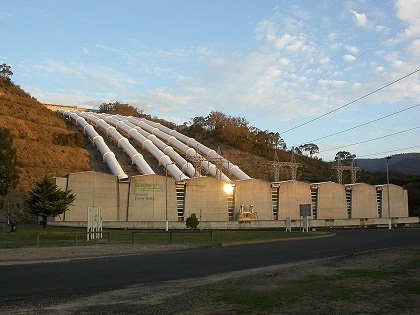
The scheme’s initial design saw it collecting and storing water that would have otherwise flowed east down the Snowy River to the coast. It was used for irrigation and environmental purposes. The engineers diverted that water through trans-mountain tunnels and power stations, and eventually released the water west of the Snowy Mountains into catchments at the River Murray and the Murrumbidgee River.
Before the scheme, the amount of snowmelt near the Snowy River region would cause floods, which in turn would make life harder for farmers by resulting in drowned crops. Therefore, the Snowy Mountains Scheme was a welcome workaround.
As population rates have grown to 24.6 million in Australia, compared to the eight million in 1949 when the Snowy Mountain Scheme began, an expansion of the hydroelectric project was deemed necessary. In 2017, Snowy Hydro asked professional engineering and development consultants SMEC, to undertake a feasibility analysis of a new phase of the Snowy Mountain Scheme.
In February 2019, the project was officially approved, which would see the Australian federal government pumping AU$1.38 billion into the project.
The scheme’s expansion will see pumps transporting water from the Talbingo Dam reservoir into the Tantangara. The water will flow down the waterway tunnel into the turbines that generate the electricity. At the same time, other pipes will continue to transport water back into the Tantangara.
On their website, SMEC details how the scheme works.
“Snowy 2.0 will act like a giant battery by absorbing, storing, and dispatching energy. Snowy 2.0 will pump water using electricity at times of low demand and store it in the upper reservoir. Then, when energy is needed most, the stored water will be used to generate and dispatch electricity within minutes. Pumping water at times of low demands means that Snowy 2.0 will have water ready to use for energy generation at times when consumers need it most.”
The project will add 2,000 megawatts of energy generation and provide 175 hours of storage for the National Electricity Market. The project is expected to power over half a million homes in Australia. Therefore, to ensure that demand is met over and above what Australia requires on any given day, Snowy 2.0 will work in tandem with wind and solar setups to ensure that there will be enough energy to go around when customers need it.
As part of the expansion, 27 kilometers (17 miles) of new tunnels must be dug. The construction of the project is set to conclude in 2024. Contractors, however, say that the project may take longer than expected and could only be in operation in 2027. The engineers — extremely confident that the project will be done by 2024 — say the hydro scheme will have a long life cycle.
One of the major plus points for Snowy Hydro 2.0 is that all of the infrastructure is to be built underground. Engineers say this makes the environmental impact of the project significantly less than what the alternative may have been.
Australia is pushing forward with the project despite a fairly large amount of criticism. The debate centers around what kinds of renewable energy technologies should receive more government investment.
Nonetheless, the beneficial aspects of the project for Australians may outweigh some of the criticism. More jobs for Australian engineers and a renewable source of energy are positive spin-offs to the project. Two thousand four hundred new jobs are a result of the construction phase, and 5,000 new jobs will exist after construction is complete.
Works Cited
“Snowy 2.0.” Smec, www.smec.com/what-we-do/projects/Snowy-2-0.
“Snowy Hydro: Renewable Energy.” Snowy Hydro | Renewable Energy, www.snowyhydro.com.au/.
- Details
- Written by: Quintus Potgieter
Volkswagen Group South Africa intends to take its manufacturing plant in Uitenhage, a town in the Eastern Cape Province, off the national electricity grid.
It is not surprising that companies are looking at more sustainable (and renewable) means of powering their facilities in South Africa. The country’s state-owned electricity utility has been plagued with problems in 2019 that have forced them into scheduling load-shedding on several occasions during the year. The impact of the resulting power cuts reportedly costs the country R2.5 billion (US$181 million) in business revenue every day the lights are off.
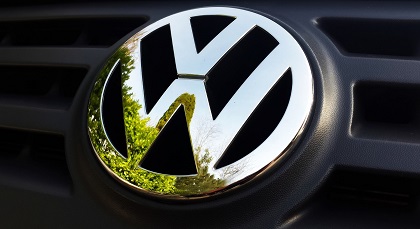
Thomas Schaefer, chair and MD of VWSA, explained how the power cuts affect the manufacturing plant.
“The robots are in the welding process, which takes about 30 seconds,” he said.
“If you get a spike in between, the robots forgets where it is. It’s an immediate shock and everything comes to a standstill. For safety reasons, you have to bring everything back into zero position but have potentially lost all the bodies in the shop that are half welded or damaged, which is a complete disaster. The spikes happen at least once a week. The cost of these lost bodies is easily into the double-digit million rand and impacts our profit margins.”
Volkswagen needs to keep its factory running as sustainably as possible — the factory has accounted for the production of over one million vehicles in 23 years. On 6 September, the milestone 200,000th VW Polo rolled off the line in Uitenhage.
Volkswagen’s plan to circumnavigate the power cut anomalies is to power their facility with biogas. To ensure the facility keeps running through the national grid’s down-time, VW has been investing in inverters — but the power cuts are becoming more frequent, and more needs to be done to keep the facility running.
Local abattoirs, fish facilities, and chicken farms will sustain the biogas facility in part, with other food companies sending their rotten produce to help power the factory.
Schaefer told media they expect to be running their facility off biogas in the next two to three years. The biogas facility will be set up near their factory and will feed electricity directly into the plant. The construction of the facility is set to cost them R3.5 billion (approx US$239 million) — which will include a waste separation setup.
The biogas facility will produce 600 kilograms of fertilizer ton of organic waste utilized during its operations. A positive spinoff for Volkswagen is that the fertilizer can be sold for a profit. They could reportedly earn US$400 per ton of fertilizer.
A delayed project?
The only thing keeping VWSA from getting on with the construction of the biomass facility is a signature from the minister of energy in South Africa. VWSA seems confident that they will be getting the green-light due to the electricity distribution issues Uitenhage has been facing.
It is in the region’s best interest to allow businesses to generate their own electricity and not put further pressure on the national grid. Furthermore, VWSA claims that the new plant could help curb the unemployment crisis South Africa is facing. They say the facility could add 1,000 jobs to the country, where the unemployment rate currently stands at 29%.
The company had to initially persuade the German parent company that the biogas facility was a good idea. They used the case of BMW South Africa, who have been utilizing biogas in one of their manufacturing plants since October 2015.
BMW utilizes a company named Bio2Watt to power its Rosslyn manufacturing plant in Pretoria. The company converts 300 metric tons of organic food waste and agricultural waste into methane-containing biogas for energy generation every day. VW’s system could work very similarly.
As South Africa’s energy and water scarcity issues are expected to plague the country well into 2020, manufacturers who account for a lion share of the export product in the country, look to innovative ways of powering their facilities. Renewable, clean, and reliable energy is what these manufacturers are interested in utilizing, and it is an exciting area of innovation that will produce more revelations in the coming months.
Works Cited
Cokayne, Roy. “VW to Take Its Uitenhage Plant off the Grid.” Moneyweb, 23 Oct. 2019, www.moneyweb.co.za/news/companies-and-deals/vw-to-take-its-uitenhage-plant-off-the-grid/.
“South Africa's Biogas Pioneer.” BMW Group, www.bmwgroup.com/en/responsibility/sustainable-stories/popup-folder/biogas-pioneer.html.
“VW to Take Its Huge Uitenhage Plant off the Eskom Grid.” TechCentral, 24 Oct. 2019, techcentral.co.za/vw-to-take-its-huge-uitenhage-plant-off-the-eskom-grid/93526/.
- Details
- Written by: Quintus Potgieter
Australian and American engineers are working on a series of space missions that could ultimately culminate in putting humans on Mars.
The first mission, named Artemis, will involve getting humans back on the moon in 2024. It is expected to see the first woman walk on the lunar surface.
 Australian Prime Minister Scott Morrison visited the National Aeronautics and Space Administration on the 21st of September in Washington. The two nations’ space agencies have signed a memorandum of understanding that will see an exchange of engineering technology and expertise that will facilitate the continued development of the upcoming lunar and future Mars missions.
Australian Prime Minister Scott Morrison visited the National Aeronautics and Space Administration on the 21st of September in Washington. The two nations’ space agencies have signed a memorandum of understanding that will see an exchange of engineering technology and expertise that will facilitate the continued development of the upcoming lunar and future Mars missions.
Australia will spend US$150 million over the five collaborative years. According to the Queensland Times, the partnership will see the Australians delivering automated robots for use in space and telecommunications setups that will communicate between earth and the moon.
Nonetheless, Australia’s continued involvement with NASA is good news for future engineers in Australia.
“We’re backing Australian businesses to the moon, and even Mars, and back,” said Prime Minister Morrison.
“There is an enormous opportunity for Australia’s space sector which is why we want triple its size to $12 billion to create around 20,000 extra jobs by 2030. The growing amount of space sector work and innovation will also inspire the next generation to see the future of a career in these fields for the long term.”
Australia has partnered with NASA in the past; the deal that has been signed extends this partnership into the future.
“It’s been an incredibly cooperative relationship going back to the Apollo program into the moon landing,” A White House statement about Prime Minister Morrison’s attendance read.
“And what we are trying to do in this visit is to expand the longstanding cooperation into the next frontiers - the moon and Mars. And I think what you will see is that we are going to have some proposals on the table that will further integrate Australia and the United States into conquering those new frontiers.”
In a statement, NASA said, “Saturday’s joint statement strengthens the relationship between Australia and the U.S. and broadens the community of nations joining NASA in further exploration of the Moon, Mars, and beyond.”
Simulating Mars
Not only is Australia lending a hand on the technology and expertise side, but they are also letting engineers and scientists run wild in their backyard. NASA and the European Space Agency (ESA) have been setting up Mars simulations in the remote region of Pilbara in the north of Western Australia.
NASA was teaming up with the University of New South Wales Syndey’s Australian Centre for Astrobiology. They enlisted the help of these scientists to demonstrate how they go about identifying signs of life through the analysis of ancient rocks. Pilbara is home to the oldest fossilized lifeforms on earth; they go by the name ‘stromatolites.’
The demonstration will help NASA inform its NASA rover teams and eventual astronauts who eventually go to Mars what to look for on the surface of the red planet.
Director of the Australian Centre for Astrobiology, Martin Van Kranendonk, said, “It’s remarkable that the history hidden in the fossil record of ancient rocks from Australia’s Pilbara region will be vital for answering the question -- is there life on Mars? We were able to investigate signs of life’s earliest footholds in a variety of geological environments and then had extensive group conversations not only about what to sample but how to sample to maximize the possibility of mission success.”
Van Kranendonk concluded, “Just as the Apollo astronauts visited areas of geologic interest on Earth before they journeyed to the Moon, the scientists of Mars 2020 and ExoMars are doing their due diligence before their missions make the 100-million-plus-mile trip to the Red Planet”.
Works Cited
Alexander, Donovan. “Australia Will Be Assisting with NASA's Upcoming Lunar and Mars Missions.”
Interesting Engineering, Interesting Engineering, 22 Sept. 2019, interestingengineering.com/australia-will-be-assisting-with-nasas-upcoming-lunar-and-mars-missions.
Curtis, Katina. “Australia Makes Space Deal with NASA.” Queensland Times, www.qt.com.au/news/australia-makes-space-deal-with-nasa/3836712/.
Higgins, Isabella. “NASA Is Scouring the Outback for Clues to Mars. But the Evidence Is Being Stolen.” ABC News, 1 Sept. 2019, www.abc.net.au/news/2019-09-01/nasa-in-western-australia-looking-for-clues-to-mars-mission/11452250.
- Details
- Written by: Quintus Potgieter
“Engineers can be a part of the solution. We all need to get together as a planet and do it collectively.”
Those were the words of engineer and sustainability consultant at BuroHappold Engineering, Trevor Keeling. He was taking part in the Global Climate Strike along with 1,799 other employees of BuroHappold Engineering worldwide who stopped work to encourage better climate practices from government and businesses alike.
In the last week of September, people in over 150 countries gathered to demand an end to what they describe as the ‘age of fossil fuels.’ Construction professionals, civil engineers, and architects were part of these strikes.

The Green Building Council in the United Kingdom skipped work on Friday the 20th of September to protest in London. The Royal Institute of British Architects (RIBA) supported the movement too.
The UK Green Building Council (UKGBC) wrote on LinkedIn, “The built environment is a significant contributor to carbon emissions. We believe our industry must make our voices heard to demand urgent climate action to achieve net zero carbon buildings. That is why we are joining with our members at the global climate strike this Friday.”
The UKGBC reports that the built environment contributes to around 40% of the UK’s total carbon footprint. They blame the growing carbon footprint on the way the construction industry implements heating in buildings.
“Direct emissions from fuel use in existing buildings rose for the second year running in 2016, mainly due to heating. Heating alone results in 10% of the nation’s carbon footprint, and homes are more significant than all other building types put together. Decarbonizing our heat supply is one of the big policy challenges ahead. Another challenge is the carbon embodied through construction. Annual embodied emissions alone are currently higher than the GCB’s target for total built environment emissions by 2050.”
More reflection on the cards
UK Construction Week 2019 ran from October 8-10. The fifth annual event took place in Birmingham this year and brought construction professionals together to reflect on the sustainability of the industry. The key focuses were:
- Modern methods of construction (MMC)
- Sustainability
- The digital revolution
- Diversity in the workforce and how they impact risk management, productivity
At the innovation stand at the UK Construction Week, Mitsubishi Electric demonstrated its low-emissions answer to heating technologies, to meet the challenges of the climate emergency. The company has engineered a heat pump named the Ultra Quiet Ecodan and is hoping to make home heating and cooling more efficient.
“The government has already recognized how important air source heat pumps will be for the future of low carbon heating in the UK and is forecasting one million sales a year by 2030,” Mitsubishi Electric manager for renewable heating systems Max Halliwell said.
“One of the key areas that will affect adoption of these energy-saving systems is noise, which is why Permitted Development exists, and these new units are designed specifically to overcome any issues with noise.”
Mitsubishi says that the sound pressure level on the heat pump is only 45dB(A), which for homeowners will be very quiet. 40db(A) is the average home noise, with regular conversation or background music being 60db(A). Therefore, it would be whisper quiet — which is beneficial to the homeowners over the long term.
Furthermore, it is the earth’s health the UK government is interested in too. An air-source heat pump is a system that transfers heat from the outside to the inside of a building. The Ecodan takes renewable heat energy from the air and pumps it into a building. For every 1kW of power it utilizes, it produces 3kW of heat energy.
It is clear that the future of the construction of buildings requires innovative solutions in the realm of electrical engineering. Cleaner technologies are being introduced to the market, which will be increasingly necessary to quell the fears of the society who are faced with a changing climate. Until then, schools and workplaces might face further future-focused protest action.
Works Cited
Living Environment Systems, 16 May 2018, les.mitsubishielectric.co.uk/latest-news/ultra-quiet-ecodan-takes-heat-pumps-to-the-next-level.
“Climate Change - UKGBC - UK Green Building Council.” UKGBC, www.ukgbc.org/climate-change/.
Week2019-09-23T11:27:00 01:00, Sponsored by UK Construction. “Innovation, Change and Reform at UK Construction Week.”
Building, 23 Sept. 2019, www.building.co.uk/sponsored-content/innovation-change-and-reform-at-uk-construction-week/5101757.article.
- Details
- Written by: Quintus Potgieter
During the Great Recession of 2008, in the United States engineering companies began closing down. General Motors in Dayton, Ohio, was one such company that had to shut its doors due to the economic downturn.
This meant a factory was left empty and ready for a new tenant, and 2,000 workers were out of jobs.
Eventually, a new tenant from 7000 miles away, made their way into town in 2013. This was Fuyao Glass Industry Co. Ltd., a company owned by a Chinese billionaire Cao Dewang.

Fuyao is China’s largest automotive glassmaker that exports to both Chinese and international regions.
The factory takeover is the focus of a new documentary, ‘American Factory.’ It is the first film produced by Michelle and Barack Obama’s production company and was released on Netflix.
The documentary delves into the several complexities an engineering workplace would naturally see when two cultures meet. Factory workers used to an American leadership style quickly learn the intricacies of having Chinese managers presiding over them.
In the film, a newly employed American Furnace Supervisor is taught how the factory works by a young Chinese Furnace Engineer named Wong. Wong has 20 years of experience with furnaces inside glass factories.
The two are compelled to build up a working relationship. Mandarin-speaking Wong has to train English-speaking Rob.
“Wong and I have spent a lot of time together with him teaching me everything. Mother’s Day, we spent the whole weekend working together with our little translators talking back and forth. That’s when they told me that they had to be here two years, away from their family, no extra pay. That really made me start thinking and appreciating what they’re doing for us more and more,” Rob, the Furnace Supervisor in the documentary, said.
Automating the factory
The documentary ends with the directors guiding the attention of the viewer to the rise of automation that the world is seeing today. Inside Fuyao’s factory in Ohio, KUKA Robots have replaced some of the workers in the factory.
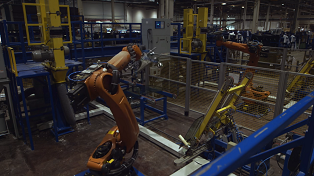
Workers who once picked and placed glass panes are no longer doing the job. The documentary shows a statistic about how automation is automating-out some of the workers in factories across the globe.
“Up to 375 million people globally will need to find entirely new kinds of jobs by 2030 because of automation. How workers, governments, and businesses tackle these seismic shifts will define the future of work.”
The globalization of engineering companies has led to a fusion of workplace cultures and labor practices around the world.
Works Cited
“American Factory.” Netflix Official Site, 21 Aug. 2019, www.netflix.com/watch/81090071.
Mui, Ylan Q. “A Chinese Billionaire Is Staking His Legacy - and Thousands of American Jobs - on This Factory in Ohio.” The Washington Post, WP Company, 26 Oct. 2016, www.washingtonpost.com/news/wonk/wp/2016/10/26/a-chinese-billionaire-is-staking-his-legacy-and-thousands-of-american-jobs-on-this-factory-in-ohio/.
- Details
- Written by: Quintus Potgieter
Turning waste into a source of power is a big opportunity in the modern age. With the amount of plastic that is produced every day, building a cyclical ecosystem that can reuse plastic quickly is one way to reduce waste.
Emerging technologies invented by collections of scientists and engineers are springing up to assist with ridding the world of an overload of plastic.
A team of scientists at Washington State University has been hard at work turning plastic waste products into jet fuel. Hanwu Lei, an associate professor at Washington State University’s Department of Biological System Engineering said, “Waste plastic is a huge problem worldwide. This is a very good and relatively simple way to recycle these plastics.”
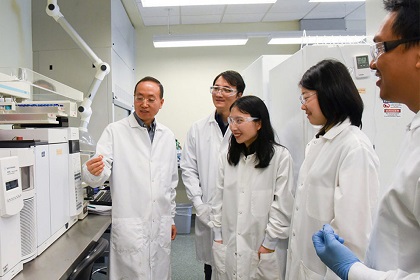
The team’s project saw them mixing low-density polyethylene and daily kinds of plastics like water bottles, milk bottles, and plastic bags. They reduced the plastic down to the size of a grain of rice.
The plastic granules are then placed atop activated carbon in a tube reactor that runs between 430 degrees Celsius to 571 degrees Celsius — the carbon acts as a catalyst by speeding up the chemical reaction.
“Plastic is hard to break down. You have to add a catalyst to help break the chemical bonds. There is a lot of hydrogen in plastics, which is a key component in fuel,” Lei explained.
The result of their process is a hydrogen-based fuel that equates to 85% jet fuel and 15% diesel fuel. The catalyst can then be reused on more waste plastic.
“We can recover almost 100 percent of the energy from the plastic we tested. The fuel is very good quality, and the byproduct gasses produced are high quality and useful as well,” Lei said.
Entrepreneurs are trying to get in on the business side of turning plastics to fuel, as well. Sierra Energy raised US$33 million in a round of investor funding.
They have a patented technology named FastOx. It is a process of gasification which sees oxygen and steam blasted at high temperatures in a modified furnace filled with waste. In turn, this leads to a chemical reaction that creates syngas.
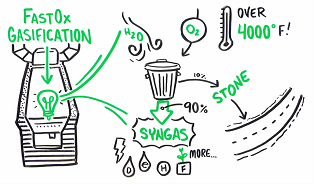
CEO of Sierra Energy, Mike Hart, told media, “It allows you to recycle the entire waste stream. The way we do that is by bringing the temperature of waste up to 4,000 degrees Fahrenheit, twice the temperature at the core of a volcano. At that temperature, everything breaks down molecularly.”
FastOx says that municipalities, landfills, waste producers, and developers should be looking at implementing the FastOx gasification technology. This syngas can be used to produce electricity, diesel, ethanol, hydrogen, fertilizer, and more.
The process produces 90% fuel. The ten percent of material left over is liquefied and recovered as metals and stone, which is sold off to construction companies that build roads — where it becomes part of the road base. As a result, there is almost nothing wasted; everything is reused.
The benefit of the processes from the University of Washington and Sierra Energy is that they are low-cost, efficient processes that can be replicated across a plethora of industries that produce waste plastics.
Works Cited
Peters, Adele. “This Startup Just Raised $33 Million to Vaporize Trash.”
Fast Company, Fast Company, 29 July 2019, www.fastcompany.com/90382101/this-startup-just-raised-33-million-to-vaporize-trash.
staff, Science X. “Research Group Finds Way to Turn Plastic Waste Products into Jet Fuel.” Phys.org, Phys.org, 3 June 2019, phys.org/news/2019-06-group-plastic-products-jet-fuel.html.
- Details
- Written by: Quintus Potgieter
Globally, the fast-food industry generates revenue of more than US$570 billion, an amount higher than the economic value of many countries. With no signs of slowing down, fast food is an unbeatable global leader amongst industry, and they are now looking to automation to make their food even faster.
McDonald’s, the largest fast-food chain in the world, is aiming to automate almost every aspect of their operations so they can serve customers as quickly as possible. The starting point is replacing the most repetitive tasks within the restaurant, such as deep-frying operations and meal packaging.

Initial steps have already been implemented, with a majority of McDonalds’ now featuring automated kiosks for food ordering. The next move forward will be focusing on the drive-through experience and how it can be made more efficient. McDonald’s, according to Bloomberg, make 70% of their revenue from customers who utilize the drive-thru. And therefore, making the drive-thru even quicker could push their income up further.
To achieve this, McDonald's has recently signed a deal with a tech company, Apprente. Apprente has, for the last three years, worked at refining technology for the sole purpose of making the action of order taking at restaurants much faster.
McDonald’s has effectively purchased the company and is going to be opening a new branch. Steve Easterbrook, President and Chief Executive Officer of McDonald’s Corporation, said, “Building our technology infrastructure and digital capabilities are fundamental to our Velocity Growth Plan and enable us to meet rising expectations from our customers while making it simpler and even more enjoyable for crew members to serve guests.
“Apprentaee's talented team and the technology they have developed will form McD Tech Labs, a new group integrated into our Global Technology team that will take our culture of innovation one step further.”
Apprente has designed voice-activated technology that is set to replace the drive-thru talking box. To ease any delays that may be caused by artificial intelligence, McDonald’s also recently purchased a company named Dynamic Yield.
Dynamic Yield creates personalization technologies that aim to improve the customer experience at the drive-thru and the automated order kiosks. These artificially intelligent machines will suggest certain ordering preferences for each customer. McDonald’s acquired Dynamic Yield for the US $300 million. In the example of a clothing store, Dynamic Yield shows how they personalize a customer’s experience:
Nonetheless, Apprente is already testing out its technology in select McDonalds’ projects in the United States. They say that the AI-powered tech can hold a perfect two-way conversation with humans — and can even understand other languages than English. At one McDonald’s branch, the company has reportedly implemented the AI voice solution and further equipped the kitchen with robotic fryers that prepare the food.
“From early on, it was clear to us that McDonald’s is truly committed to technology innovation and that it was on a mission to spearhead the QSR industry. In partnership with McDonald’s, we set out to deliver a customer-focused solution, all while building a great team and culture,” Apprente said on their website, announcing the McDonald’s acquisition.
McDonald’s is by no means the only franchise looking to reduce the employee headcount. Globally famous coffee conglomerate Starbucks is acquiring software startups as well. The company has just purchased a stake in Brightloom.
Brightloom’s software will help the company open its menu up to an online system that customers can purchase from instead of queuing in-store. According to CNBC, ordering online increases a customer’s spend by twenty percent when compared to the alternative in-store cash purchasing.
Automation is about maximizing profits and ensuring efficiency. Some warn that over-automating the sector might automate-out most of its staff, leaving those employees jobless. For now, though, the restaurants are not announcing any staff cutbacks. They are instead trying to show how technology can free up some of its employees from doing menial tasks inside the business. They are trying to open up new pathways for productive work inside their companies, and automation has a big part to play. Nonetheless, for company and customer, the automation push is becoming a win-win.
Works Cited
Bloomberg.com, Bloomberg, www.bloomberg.com/news/articles/2019-09-10/mcdonald-s-buys-startup-to-add-automated-drive-thru-ordering.
Apprente. https://www.apprente.com/
McDonald's cutting calories in Happy Meals | 2018-02-15. https://www.foodbusinessnews.net/articles/11308-mcdonalds-cutting-calories-in-happy-meals
Afifi-Sabet, Keumars. “McDonald’s Orders up an AI Startup to Boost Drive-Thru Tech.” IT Pro, Dennis Publishing Ltd., Sept. 2019.
- Details
- Written by: Quintus Potgieter
The Royal Academy of Engineering MacRobert Award is the UK’s most prestigious honor for engineering innovation, recognizing “teams that demonstrate outstanding innovation, societal benefit and commercial success”. In 2019, the award went to the Bombardier team in Ireland that have developed and are now manufacturing the world’s first resin-infused wing designed for use in Airbus A220 commercial aircraft.
The company behind the resin that makes the wing possible is advanced material and specialty chemicals company, Solvay. Committed to developing chemistry that addresses key societal challenges, Solvay saw this project as a step towards getting more eco-friendly planes in the sky.
“Resin infusion isn’t traditionally used in aerospace”, explains David Bacon, Account Manager at Solvay’s Composite Materials business unit. “It’s typically used to manufacture boats, and in the field of wind energy. But it’s obvious there is a lot to gain in spreading its use in commercial aircraft manufacturing.”

The company says that using composite materials in the aerospace industry will utilize less metal than a traditional aircraft build. The replacement of metals, Solvay says, will help with increasing corrosion resistance, simplifying maintenance and making aircrafts lighter.
These developments also come at a good time as there is a significant mainstream focus on Co2 emissions and how much the aerospace industry is contributing to this phenomenon.
How it’s made
The wing is manufactured through a process known as a resin-transfer infusion (RTI), which involves putting dry carbon fiber into a mold and then filling it with liquid resin. The mould is then heated and pressured to obtain a solid fiber-reinforced part.
This process ensures faster production of simpler materials with stronger mechanical properties, which is largely beneficial to the aircraft manufacturing industry.
“In conventional wings, there are many parts to the torque box,” says director of quality, airworthiness, and technology strategy at Bombardier, Gavin Campbell.
“However, RTI allows the torque box to be made up from only four components…greatly reducing complexity in manufacturing and enabling improvements in mechanical performance because there are fewer points where the structure can fail.”
Bombardier’s team also built a fuel and hydraulic system into the wing. And to win the engineering award, one of the prerequisites was that the wing had to be lightning-proof. The engineers designed a special polymer bracket fitted with insulation that would dissipate the static electricity once lightning struck.
The factory where the wings are manufactured holds complex assembly stations that work on the wing after the RTI process. The continued assembly inside the factory is an unorthodox process with traditional wings normally sent off to another factory to continue the ongoing assembly process.
“It’s a totally digital factory, with all the sensors, use of simulation and digital twins that implies,” Campbell said. “However, we don’t tend to use terms such as Industry 4.0 because these are all developments of systems and techniques that we were using in the aerospace industry anyway.”
Overall, the new wings have been a great success for Bombardier, their sales helping deliver the first company profit for five years in 2018. The company delivered more than 25 wing sets in 2018, and this is expected to increase significantly in 2019.
Works Cited
Nathan, Stuart. “The Wing Master: Bombardier's Award-Winning Aerodynamic Production.” The Engineer, 9 Oct. 2019, www.theengineer.co.uk/wing-master-bombardier-award-winning-aerodynamic-production/.
- Details
- Written by: Quintus Potgieter
Digital technologies are surpassing the more traditional methods of running engineering companies. As industrial automation begins to infiltrate engineering sectors, companies are drastically changing the way they operate to keep up.
On the 26th of September 2019, Jaguar Land Rover (JLR) opened a new automotive creation and development center in England. The center will bring JLR’s engineering, manufacturing, designing, research, and development teams all under the same roof.
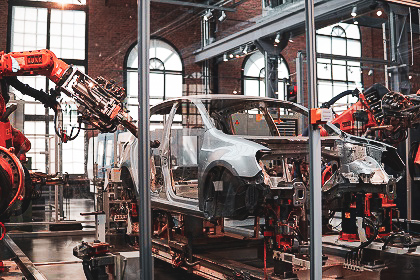
“We are now an IT company,” said JLR CEO Ralf Speth.
“We have to go away from the old way of doing things.”
The overarching theme of the facility is automation, with JLR’s entire manufacturing process now being automated, delivering a clear message that JLR is changing with the times.
Hardware has also taken a backseat at the heart of the manufacturing process, as the company has shifted its focus to new and improved smart-features within their vehicles. The challenge of creating new software is now their new priority as “100s of millions of lines of code” are currently in development.
At the launch of the site, JLR’s head of engineering, Nick Rogers, said that the number of traditional mechanical engineering staff is beginning to dwindle as the number of software, mechatronics, and electrical system engineers they require for their manufacturing process increases.
The center cost nearly one billion dollars and will be employing around 13,000 engineers, officially making it the largest car creation center in the UK. And automation is not the only trend that is making JLR rethink its future.
“Megatrends like urbanization and sustainability are fundamentally changing the automotive industry. At Jaguar Land Rover, we not only participate - we are shaping future mobility. Our vision is for a world in which zero-emission vehicles, public transport, and self-driving pods will form one smart integrated and networked transport system,” said Speth.
Destination Zero
Ralf Speth says that mobility needs to become a human right in the future. However, that gives automotive companies a mandate of making mobility as safe as possible.
Land Rover has conducted real-world tests of innovative connected and autonomous vehicle technology, and have been developing in the space for the last four years. Recently, they took a self-driving Range Rover around one of the UK’s most challenging road layouts.
<iframe width="696" height="392" src="https://www.youtube.com/embed/dKr1xfXrTys" frameborder="0" allow="accelerometer; autoplay; encrypted-media; gyroscope; picture-in-picture" allowfullscreen></iframe>
JLR is predicting that autonomous vehicles will be the answer to solving road accidents in the future. They have dedicated themselves to Destination Zero, committing to achieving zero accidents, zero congestion, and zero emissions. JLR also intends to have all of its vehicles powered by electronic means by 2020.
Jaguar Land Rover is now a picture of an innovative company that is keeping its finger on the pulse of what consumers not only want but demand.
Works Cited
Gibbs, Nick. “Jaguar Land Rover Is an IT Company Now, CEO Says.” Automotive News Europe, the 30th of September 2019, europe.autonews.com/blogs/jaguar-land-rover-it-company-now-ceo-says.
- Details
- Written by: Quintus Potgieter
In this modern age, we are constantly surrounded by batteries. From TV remotes to hand-held radios, you probably use batteries more than you realize. The lithium-ion battery industry is worth $23 billion alone and is expected to grow to nearly $100 billion by 2025.
Battery technologies have been evolving since their initial creation as our needs have continued to grow. However, as our future is looking increasingly electric, engineers and scientists are now focusing on manufacturing new eco-friendly battery technology on a scale we have never seen before.
The most positive alternative seen so far is aluminum-based batteries, being both light-weight, cheaper to make, and abundant in resources. However, there has been a consistent struggle in making aluminum batteries that compare to the energy content of lithium batteries. As far back as 2015, Stanford University researchers were mentioning that all that’s holding aluminum batteries back was the cathode material that would help increase voltage and energy density.

However, that might be all about to change. In 2019, researchers say an upgraded type of aluminum battery may soon make its debut. The Chalmers University of Technology and the National Institute of Chemistry in Slovenia have worked on a concept for a new aluminum battery they think could revolutionize the battery storage industry.
Their proposal includes replacing the graphite on the battery’s cathode with a carbon-based molecule named anthraquinone. This organic nanostructured replacement will assist the battery’s ability to absorb electrons during operation.
“Because the new cathode material makes it possible to use a more appropriate charge-carrier, the batteries can make better usage of aluminum’s potential,” says Chalmers researcher Niklas Lindahl.
“Now, we are continuing the work by looking for an even better electrolyte. The current version contains chlorine - we want to get rid of that.”
With a better electrolyte, the battery will allow ions to move between the electrodes, which will unlock the higher energy density in the aluminum battery. Therefore, developing the aluminum battery is still a work in progress, but researchers think they are closer than ever.
“The material costs and environmental impacts that we envisage from our new concept are much lower than what we see today, making them feasible for large scale usages, such as solar cell parks, or storage of wind energy,” says Professor Patrik Johansson from the Department of Physics at Chalmers University.
“Additionally, our new battery concept has twice the energy density compared with the aluminum batteries that are ‘state of the art’ today.”
The researchers’ idea is to make the aluminum battery four times as energy-dense as its lithium alternative. For applications such as electric vehicles, the added battery capacity will mean less charging required between trips.
On whether or not aluminum-ion batteries could one day replace lithium-ion, Johansson concluded, “Of course, we hope that they can. But above all, they can be complementary, ensuring that lithium-ion batteries are only used where strictly necessary.
“There remains work to do with the electrolyte and with developing better charging mechanisms, but aluminum is, in principle, a significantly better charge carrier than lithium. Furthermore, the batteries have the potential to be significantly less environmentally harmful”.
Works Cited
Leisegang, et al. “The Aluminum-Ion Battery: A Sustainable and Seminal Concept?” Frontiers, Frontiers, 2 Apr. 2019, www.frontiersin.org/articles/10.3389/fchem.2019.00268/full.
“A New Concept for More Sustainable Batteries.” Chalmers, www.chalmers.se/en/departments/physics/news/Pages/A-new-concept-could-make-more-environmentally-friendly-batteries-possible-.aspx.
- Details
- Written by: Quintus Potgieter
It’s a question more commonly asked of architects rather than engineers, how can nature inspire the design of structures? However, designing with or around the environment is becoming a common trend amidst the structural engineering industry. A newly constructed walkway in Denmark has nature as its main focus, and it is turning engineering heads.
High above the tree line at Camp Adventure in Copenhagen, a 45-meter high tower seemingly spirals into the sky above. At the top, an observer can enjoy a 360-degree view of the treetops of the Gisselfeld Klosters Forest in Denmark. The project was completed by Danish architecture firm EFFEKT and masterminded by a Danish NAVY seal named Jesper Mathiesen, who runs Camp Adventure.
A feat of engineering, the structure is a fourteen-story tower that features a spiraling walkway inside leading to the top. The structure is made entirely of weathering steel. The benefit of these steel alloys is that there is no need for painting as it has a natural rust appearance. The walkway within the structure consists of oak, which helps the structure blend in with the trees.
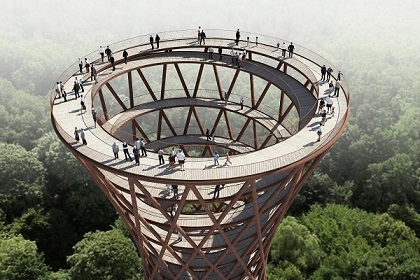
If viewed from far away, the tower has an hourglass shape, which Tue Foged, lead architect from EFFEKT, says is an intentional design that endeavors to respect the existing trees in the forest.
“Nature provides the real experience. We just made it more accessible and offered a series of new and alternative perspectives,” says Foged.
“The tower is shaped to enhance the experience of the visitor, shunning the typical cylindrical shape in favor of a curved profile with a slender waist and enlarged base and crown. This allows for better contact to the forest canopy moving up through the tower.”
The tower, which opened in March 2019, is an example of how structural engineering as an industry is looking back to nature for inspiration. However, this isn’t the first time designing with nature has occurred within the engineering industry. A decade prior, the New York High Line opened with a walkway through the natural environment of its own.
Structural reuse and reintegration
The High Line serves as an example of nature reclaiming its territory inside the concrete jungle. It’s a project that shows that structural engineering can have a secondary use.
The High Line is a 1.45 mile-long elevated linear park, greenway, and rail-trail that runs above a former railroad. It is a spur on the west side of Manhattan on the New York Central Railroad.
Over two hundred species of plants are spread out as vegetation on the former railroad in Manhattan. The High Line last utilized for railroad activities in the 1980s. The initial intention was to demolish the railway, but BuroHappold Engineering and Field Operations worked to reuse and re-integrate the line for its new purpose it serves today.
BuroHappold constructed two structures on the railway. One structure was named the Flyover, which was an elevated steel walkway engineered to appear as a levitating floor. The second structure was called the Cutout: which was a steel mesh deck providing views to the street below.
The High Line is now a park that the public can enjoy and where they can get a new feel for the city that they live in. Once a source of noise as the trains drove by, it is now a tranquil resting space.
The industrial past is now fused into the future-focused metropolis. With views of the Hudson River and the general cityscape, it is a popular destination in New York City. Encapsulating both New York’s heritage and future, while abiding by green construction imperatives, structural engineers have managed to work with the industrial past and bring it into an eco-friendly future.
Works Cited
CBS News. “A Spiraling Walk above the Trees.” CBS News, CBS Interactive, 6 Oct. 2019, www.cbsnews.com/news/camp-adventure-in-denmark-a-spiraling-walk-above-the-trees/.
Frearson, Amy. “EFFEKT Completes Spiralling Camp Adventure Tower in Midst of a Danish Forest.” Dezeen, Dezeen, 15 May 2019, www.dezeen.com/2019/05/12/camp-adventure-tower-effekt-denmark-forest/.
- Details
- Written by: Quintus Potgieter
Climate change remains one of the biggest problems our world has ever faced, and there are no signs that it will drastically improve any time soon. So engineers and scientists are coming together to investigate a controversial technique to prevent an environmental catastrophe.
Geoengineering may seem like something from a far-fetched science fiction film, with ideas ranging from mirrors in the ocean to reflect sunlight away from earth to space sunshades. However, engineers are now investigating the notion of releasing millions of tons of sulfur dioxide into the stratosphere as a potential solution to reducing the effects of climate change. The idea behind this is the particles will reflect sunlight away from earth and therefore cool the planet.
The notion originated from the eruption of Mount Pinatubo in 1991. This volcano in the Philippines erupted, spewing fifteen to seventeen million tons of white ash and sulfates up to ten kilometers into the sky. Fifteen months later, scientists combing over the data realized the particle cloud had shielded the area from the sun, with temperatures dropping by 0.6 degrees Celsius.

The idea is that aircraft will spray sulfate particulates into the lower stratosphere at 60,000 feet. The process would theoretically be equal to a volcano ejecting sulfates into the sky during an eruption. The sulfur dioxide shot up into the stratosphere forms sulfuric acid drops, which then rotate around the globe for 48 months, and successfully hinder sunlight from penetrating it. The result could be a one-degree temperature drop, which would reverse the global temperature rise of the last century.
This technique, known as stratospheric aerosol injection, is considered radical and opposed by many as they believe the effects of intentionally modifying the climate could be worse than climate change itself. In fact, in 2018, the Global Challenges Foundation published a report on major threats against humanity — and solar geoengineering was listed as one of these, as was catastrophic climate change.
At the Paris Climate Conference in 2015, governments around the world acknowledged that something needed to be done to accelerate anti-global warming effects. They set out several targets, including keeping the global temperature rise this century well below two degrees Celsius above pre-industrial levels. The deal was ratified in 2016; however, the issue remains that governments across the world are realizing they are still not on track to achieving the initial targets set out in the Paris Agreement.
This is why some scientists see geoengineering as a legitimate solution to saving our planet. The Global Challenges Foundation report explains the appeal and the risks.
“Solar geoengineering is the only known technique for quickly stopping or even reversing the rise in global temperatures. Although it does not solve the root cause of climate change, it could be used to reduce the length or the magnitude of a temperature overshoot (beyond the Paris goal) during the transition period needed for massive decarbonization at the global level or provide insurance against a potential ‘climate emergency.’
“However, we don’t know enough about the risks and potential benefits of the technology, and it carries considerable risks – in particular, it may destabilize local and global climate, as well as various elements of the global ecosystem. In addition, a sudden termination of solar geoengineering would lead to rapid and severe global warming, with no time for natural and social systems to adapt.”
The reality is that carbon emissions must be reduced urgently because things will only get worse. The report states that if the temperatures increased by three degrees Celsius, most of Bangladesh and Florida would drown. Other coastal cities would also be flooded, which would then create hundreds of thousands of climate refugees across the world.
As a result, a team of scientists at Harvard University is hoping to implement the first in situ geoengineering experiment to determine whether it is a viable solution. However, they are facing critics who worry that once we start experimenting with these radical ideas, we will be heading down a slippery slope.
To appease those with fears about the result of this experiment, Harvard University has put together an advisory committee to ensure that appropriate steps are taken to mitigate health and environmental risk and ensure they operate transparently.
Scientists first proposed the experiment in 2014. It will see researchers launch a scientific balloon with sensors and propellers 20 kilometers above the earth. They will release between 100 grams and two kilograms of calcium carbonate particles in a kilometer-long plume. This is limestone dust and is less likely to deplete the ozone layer than sulfates.
The balloon will fly through the plume, and its sensors will measure how far the particles scatter, how they interact with other compounds in the atmosphere, and how much light they reflect.
The project’s principal investigator Frank Keutsch explained in a statement that they hope this experiment will inform the feasibility of geoengineering.
“If anything, I’m concerned that the current climate models make solar geoengineering look too good. If we want to be able to predict how large-scale geoengineering would disrupt the ozone layer, or the exchange of air between the troposphere and stratosphere, we need more real-world observations.”
The Carnegie Climate Governance Initiative’s Janos Pasztor is one scientist who has concerns about geoengineering experiments. Such worries include the technology affecting ocean circulation, biodiversity, disease patterns, agriculture, and causing extreme weather.
The Union of Concerned Scientists' climate and energy program’s Shuchi Talati, echoed these sentiments.
"We don't know what the regional impacts will be," Dr Talati said.
"There have been different modeling papers showing different things."
The other major issue is that a global thermostat will need be set to determine a particular global thermal temperature, creating winners and losers. While one region might experience favorable rainfall to help its agricultural industry thrive, another nation might experience devastating drought. There are now fears surrounding security risks, because who gets to control this global thermostat and what happens if it gets breached or hacked?
Mr Pasztor argues that because this technology is cheap enough to be accessible to virtually every country, the fact that it is ungoverned could have horrific political consequences.
"Imagine a situation where China unilaterally goes ahead, and a couple of years later the monsoon fails in India, and lots of people starve, “ he said.
"Even if you cannot link the failure of the monsoon to the stratospheric aerosol injection activity, people in India might think it's because of the Chinese."
Mr Pasztor helped advise on the Paris Agreement and emphasized that geoengineering should not be used to replace cutting emissions, but as insurance in case we do not meet our temperature goals. Other scientists fear that an overreliance on geoengineering will undermine efforts to reduce greenhouse gases.
In a previous news article, we covered what engineers could do to help save the planet. These other geoengineering solutions included marine cloud brightening that would see naval ships spraying salt particles into the air, in turn brightening the clouds hanging over the sea. The brightened clouds would also deflect the sun off the earth.
Many of these advents of carbon mitigation and climate geoengineering have certain checks and balances that slow the process of their implementation. And that is perhaps a good thing. Attempting to engineer the climate raises ethical and political issues. Not to mention, scientists must conduct the experiments in the safest possible ways. However, it is encouraging to see that scientists and engineers are rising to the occasion to combat oncoming climate events that could save thousands, if not millions of lives.
Works Cited
Salleh, Anna. “A Planet-Sized Sunshade? It Sounds Far-Fetched, but Some Scientists Are Seriously Considering It.” ABC News, Australian Broadcasting Corporation, 24 July 2019, www.abc.net.au/news/science/2019-07-24/climate-hacking-to-avoid-a-global-warming-apocalypse/11300460
Temple, James. “Geoengineering Is Very Controversial. How Can You Do Experiments? Harvard Has Some Ideas.” MIT Technology Review, MIT Technology Review, 29 July 2019, www.technologyreview.com/s/614025/geoengineering-experiment-harvard-creates-governance-committee-climate-change
- Details
- Written by: Quintus Potgieter
As conserving finite resources becomes an increasing priority, scientists have been consistently successful in discovering alternate renewable energies. One of these alternatives is solar energy. Solar panels absorb powerful rays from the sun and convert them into power resources, which are used in both residential and commercial areas.
However, solar panels still suffer from a list of setbacks that offset their usefulness. One of these ailments is overheating. When solar panels are exposed to too high temperatures, their efficiency and performance is hindered.
Electrical engineers are now busy trying to figure out how to overcome the heating problem and retain efficiency. Researchers at Rice University in Texas think that they may have found the answer. The solution involves capturing the thermal photons that the solar panels release.
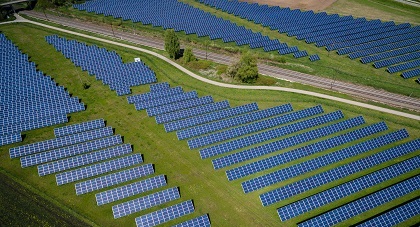
Junichiro Kono of Rice’s Brown School of Engineering explains:
“Thermal photons are just photons emitted from a hot body. If you look at something hot with an infrared camera, you see it glow. The camera is capturing these thermally excited photons.”
Solar panels essentially have nowhere to send excess photons, which is why researchers want to reroute the extra heat and convert it into more electricity. Gururaj Naik, an assistant professor of electrical and computer engineering at Rice University, told PV Magazine, “Any hot surface emits light as thermal radiation.
“The problem is thermal radiation is broadband, while the conversion of light to electricity is efficient only if the emission is in a narrow band. By squeezing all the wasted thermal energy into a small spectral region, we can turn it into electricity very efficiently. The theoretical prediction is that we can achieve 80% efficiency.”
The engineers have created a device that will direct the photons emitted as heat into the narrower band. It utilizes ‘a film of carbon nanotubes,’ which forces the electrons to move in one direction. The researchers say the device can operate at a maximum temperature of 700 degrees Celsius.
They compiled a report entitled ‘Macroscopically Aligned Carbon Nanotubes as a ‘Refractory Platform for Hyperbolic Thermal Emitters’ published in the journal ACS Photonics. The research is only in its beginning phases; however, the engineers are optimistic that panels will soon run at four times the efficiency.
Works Cited
Hutchins, Mark. “Harnessing Heat for 80% Theoretical Efficiency.” Pv Magazine International, 29 July 2019, www.pv-magazine.com/2019/07/29/harnessing-heat-for-80-theoretical-efficiency
“Macroscopically Aligned Carbon Nanotubes as a Refractory Platform for Hyperbolic Thermal Emitters.” ACS Photonics, pubs.acs.org/doi/abs/10.1021/acsphotonics.9b00452
- Details
- Written by: Quintus Potgieter
While solar and wind energy seem to be the primary sustainable energy sources mentioned in the media, tidal energy is actually more predictable. Tides can be timed in perpetuity throughout the year, whereas predicting when the wind will blow and when the sun will shine is far harder.
In a world-first, a data center in Scotland will set the bar for tidal arrays in the future. Renewable energy technology developer Simec Atlantis has turbines capturing the natural flow of water between Scotland’s northeast coast and the uninhabited island of Stroma.

There are reports that Amazon, Google, and Microsoft are interested in utilizing the technology for their data, as well. With all of the data crunching these kinds of companies do, large data centers are necessary. The issue is how much power these data centers need to use to keep our favorite websites and services up and running. Therefore, it makes sense to power them in a renewable way.
Tim Cornelius, CEO of SIMEC Atlantis Energy, said, “data is being touted as the new oil. It is arguably becoming the world’s most valuable resource, and the amount of data requiring storage is increasing at a staggering pace. However, data centres are undeniably power hungry, and the clients of data centre operators are rightly demanding power be sourced from renewable and sustainable sources.”
SIMEC Atlantis’ tidal energy site will be in Caithness in Scotland. It is expected to be the biggest tidal energy project globally once opened in 2024. However, SIMEC Atlantis northeast will not confirm which ‘world-leading data center operators’ they are talking to and signing deals with.
The company leases parts of the seabed off Scotland’s northern coast. They will be installing forty new turbines on the seabed, which will be adding 80MW to the capacity they already have installed. In 2010, the company was granted the option to develop a tidal stream project that would be given license to install up to 398MW of capacity.
They currently have the first phase — MeyGen Phase 1A — operational, which saw the deployment of four 1.5MW turbines. On their website they describe the complexities of their world-leading tidal turbines:
“Each turbine is located on an individual foundation between 250 and 350 tonnes coupled with six ballast blocks weighing 1,200 tonnes, that provide horizontal stability over the lifetime of the turbine. Each turbine has a dedicated subsea array cable laid directly on the seabed and brought ashore via a horizontal directionally drilled borehole within the foreshore bedrock.”
The MayGen array has the potential to influence electrical engineering industries all across the globe and get tidal energy powering critical infrastructure in sectors that make the world turn. Electrical engineers can also sleep easy knowing that new jobs will be opening in the renewable energy industry soon. The CEO of SIMEC Atlantis, Tim Cornelius said:
“At MeyGen we have many of the ingredients to provide clean power to the data center, including a large grid connection agreement, proximity to international fiber-optic connection and persistent cool weather. We also believe that Scotland can play a key role in the global data center industry thanks to its ready access to clean energy and we are eager to play our part at Atlantis to turn this potential into reality.”
EIT offers a range of electrical engineering programs - find out more!
Works Cited
Gardner, Elliot. “Talking Tidal as MeyGen Kicks into Gear.” Power Technology | Energy News and Market Analysis, 27 June 2018, www.power-technology.com/features/talking-tidal-meygen-kicks-gear/.
Thomas, Allister. “Plans for 'World's First' Ocean-Powered Data Centre in Scotland - News for the Oil and Gas Sector.” Energy Voice, 9 Sept. 2019, www.energyvoice.com/otherenergy/207276/plans-for-worlds-first-ocean-powered-data-centre-in-scotland/.
- Details
- Written by: Quintus Potgieter
In Southern Africa, aging infrastructure and shortages of much-needed resources are stifling the electrical engineering sector. Powering countries south of the equator is a topic much in focus in the last few years. Both Zimbabwe and South Africa have been seeing a need to balance power loads and load shed at their public energy utilities. However, Zimbabwean companies are starting to get smart with how they manage their power outages.
Econet Wireless Zimbabwe, the largest provider of telecommunications services in Zimbabwe, have resorted to contemporary solutions to their modern-day problems. If Econet’s servers go down, the country suffers economically.
Telecommunications currently plays a vital role in the economy of Zimbabwe. Many people in the country are doing transactions via mobile means. The country is currently experiencing a shortage of physical paper money, and so the transactions are done digitally.
To further exacerbate the problem, in May, Zimbabwe began load-shedding after the government announced it was undergoing power shortfalls due to aging power stations and heavy usage occurring in the winter months. According to reports, the power in Zimbabwe can be switched off for 18 hours a day.

Without Econet’s service, according to Bloomberg, 6.7 million people would be without a way to pay for groceries or tip waiters.
Luckily, southern African born Elon Musk’s company, Tesla Inc, has engineered the kinds of technology that can keep the lights on for the African country and companies. Econet, with the assistance of Distributed Power Africa, have installed 520 Powerwall batteries across the telecommunications company’s 1,300 base stations around the country.
Powerwalls are lithium-ion batteries that can be charged up via photovoltaic solar panels.
Norman Moyo, the chief executive officer of Distributed Power Africa said, “telecommunications have become the lifeblood of the economy. If the telecom network is down in Zimbabwe, you can’t do any transactions.”
Distributed Power Africa is looking at rolling out similar projects to other African countries that are struggling to keep their national grids working. Tesla has been shipping their Powerwall technology out to regions that lose access to electricity to try and keep the lights on for crucial infrastructure.
Before the arrival of the Powerwalls in Zimbabwe, Econet’s base stations were utilizing Diesel generators as backup power when the national grid went down. However, fuel shortages soon arose in the troubled country.
The batteries, costing US $6,500 each can power the service provider’s base stations for ten hours without help from the national grid. Backup generators and the arrays of solar panels can pick up the rest of the hours of the day when the sun is shining, granted there is an 18-hour power outage in the area. In the evening, the Powerwall can kick in and keep the base stations running.
The Powerwall was initially designed for the powering of homes in peak power usage times, but their usefulness in business has also been realized. In the United States, some companies are utilizing the much bigger Tesla engineered Powerpacks — they are essentially many stacked Powerwalls that can power an entire building and its infrastructure.
Engineers around the world are called to familiarize themselves with the battery technologies so that they can one day restore power to the regions that need it. Lithium-ion batteries are changing the way things are powered down south, but more needs to be done to bring traditional electric systems to use carbon-neutral technologies such as the Tesla Powerwall.
In neighboring South Africa, Twitter-ers are asking Elon Musk how long it might be before the country sees Tesla Motors’ vehicles being exported to the southern parts of the continent. Responding to a question on Twitter on the 29th of August, Elon Musk said he would love to bring the vehicle to South Africa, but import duties were far too high — especially for electric vehicles. Something the government has promised to change.
There seems to be a demand for the new electric ways of powering several industries in the southern hemisphere. Zimbabwe utilizing lithium-ion batteries to power their businesses is a huge leap forward and is indicative that African countries are rapidly surging towards a decarbonated, fourth industrial revolution future. Engineers are going to have to study the many facets of this new electrical engineering world they have been waiting to meet.
EIT offers a range of electrical engineering programs - find out more!
Works Cited
Bloomberg.com, Bloomberg, www.bloomberg.com/news/articles/2019-09-01/tesla-batteries-are-keeping-zimbabwe-s-economy-running.
Sguazzin, Antony. “How Zimbabwe Is Banking on Tesla.” BusinessLIVE, Business Day, www.businesslive.co.za/bd/companies/2019-09-02-how-zimbabwe-is-banking-on-tesla/.
- Details
- Written by: Quintus Potgieter
Mechanical engineers have, for a long time, been using the natural world as inspiration for robot design. However, the latest soft-robot that is taking inspired by nature might creep some people out. What started as an inadvertent thought from a mechanical engineering student has turned into a real robot. And it is in the shape of a leech.
This collaborative research project will unsurprisingly be called the ‘LEeCH’ (Longitudinally Extensible Continuum-robot inspired by Hirudinea). Hirudinea is a subclass of parasitic or predatory worms found in nature that belong to the phylum Annelida.
The original idea for the robot came from a Doctoral student in the Department of Mechanical Engineering at the Toyohashi University of Technology. He said, “I came up with the idea in the bathroom of my house. The shower hose went wild as if it had a life when I inadvertently turned on the faucet at maximum. Then an idea occurred to me that if I could manipulate a hose, I might be able to make a robot with the dynamic movement of a living creature.”
The researchers wanted to mimic a leech’s flexibility. The longitudinal muscles are what they are most interested in. The elongating and retracting of the body for the purpose of movement got the researchers designing something that could potentially be as flexible in the future.
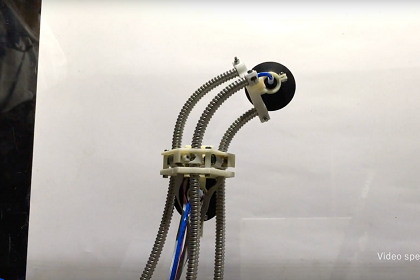
The collaboration involves Dr. Tomoaki Mashimo, Associated Professor of the Department of Mechanical Engineering at the Toyohashi University of Technology and Dr Fumiya Iida, Reader in Robotics at the Department of Engineering at the University of Cambridge.
However, if you assumed the robot was completely fleshed out and built with the most cutting edge materials, you would be wrong. The robot is fabricated out of suction cups and shower hoses. But, it is the 3 actuators that do the important work:
Immediately upon seeing what the first draft robot is capable of doing, the potential future uses of these robots become clear. Dr. Fumiya Iida explains, “climbing robots have a wide range of potential applications, including building inspection, maintenance, construction, and search and rescue tasks.
“Climbing robotics is still a challenging research field both theoretically and practically, but together, we have made significant contribution to advanced this field by creating a robot, inspired by leeches that can transition from one surface to another and can climb a vertical wall -- without any constraints.”
According to New Atlas, the leech-like climbing technique — which involves scaling a wall and transferring to the other side of a wall — is a world-first for robots. Climbing robots would be sought out by several engineering industries that desire constant oversight of their machinery even in those hardest to reach areas.
There is more work to do on refining the robot, however. The researchers intend to make the robot’s movement smoother. This means changing how stiff the tubes are by lubricating the inside of the cavity with liquids. The engineers can also work on making the robot much softer and more flexible so that the robot can reach its full potential and one day be used in those countless engineering sectors. And it all started with a shower hose, and a mechanical engineer’s imagination - with a little help from nature too.
EIT offers a number of programs related to mechanical engineering - find out more!
Works Cited
EurekAlert. “壁登りロボットの概要.” EurekAlert!, www.eurekalert.org/pub_releases/2019-05/tuot-iba051019.php.
- Details
- Written by: Quintus Potgieter
Manufacturers are seeking ways to make their global supply chains more flexible. Luckily for them, wireless Internet of Things technologies are empowering these factories and making processes more efficient than ever before. Ericsson, a giant in automation technology engineering, reported that “IoT connections are set to pass the 4 billion mark by 2024.”
In Ericsson’s blog entitled ‘The future of manufacturing is smart, secure and stable,’ they outline that companies with production lines are trying their best to integrate the Industrial Internet of Things technologies, and the market is heating up with competitiveness.
Essentially, manufacturers who create the most novel interconnected system in their factories, underpinned by Industrial Internet of Things technologies, will get more work done and generate more profits due to the efficiency of their operations. That requires the fastest interconnectivity technology available to the market.
This is where 5G wireless internet technology comes in. 5G promises faster speeds and unparalleled latency for factory-connected equipment, making the technology a bone of contention in global politics — especially in the case of the ongoing trade war between the United States and China. The global rollout of 5G technologies is happening — and fast. For instance, Chinese telecom Huawei’s aim is to ‘build a fully connected, intelligent world.’
Ericsson has published their findings in their Mobility Report. The report casts industry projections while analyzing the latest trends in the mobile data industry with regards to 5G, IoT, fixed wireless access and more. In the report, the graph relating to countries’ uptake of cellular IoT connections, shows that North-East Asia is expected to continue growing the number of operations IoT connections well into 2024.

In the United Kingdom, as the government prepares to separate from the European Union, fiber internet technology and 5G connectivity are going to be a vital mechanism of their efforts to transform factories in the country to enter the market and keep the economy strong.
The UK government is ensuring that even the most rural parts of the country are receiving high masts connecting the areas with 5G technology so that they can begin digitally revolutionizing markets in those regions. On top of that, online education and training is something that rural Britons can also start to pursue from where they are based. The power of mobile internet connectivity can affect many levels of society within any given geographic area.
Broadband service provider EE, in the United Kingdom, have been trying to educate the general populace about the benefits of 5G and how the speeds are equipped to transform several industries in the country:
Companies race to deploy 5G technologies
A survey by research firm Gartner reports that two-thirds of organizations are looking to have their 5G setups deployed by 2020. Organizations are also trying to ensure that they get their entire manufacturing setups with 5G readiness. Gartner reports that 59 percent of organizations surveyed are looking to implement 5G-capable networks by next year.
Sylvian Fabre, a senior researcher at Gartner said, “the figure for IoT communications is surprising, given that other proven and cost-effective alternatives, such as Narrowband IoT over 4G and low-power wide-area solutions, already exist for wireless IoT connectivity.
“However, 5G is uniquely positioned to deliver a high density of connected endpoints -- up to 1 million sensors per square kilometer.”
Manufacturers benefit massively from the ‘high density of connected endpoints’. An entire network of interconnected sensors that take about a millisecond to interface with each other is something that will empower the autonomy of manufacturing systems. Delays in manufacturing plants may be a thing of the past with 5G.
With 5G being normalized rapidly, prospective engineering students should be familiarizing themselves with 5G and the telecommunications technologies surrounding it, because once they graduate, they will likely see the technology in their future workplace. The more and more engineering industries that utilize these technologies, the closer the supply chain gets to being revolutionized through smart-manufacturing.
EIT offers a variety of courses in the industrial automation sector - find out more.
Works Cited
“Ericsson Mobility Report: Read the Latest Report.” Ericsson.com, 30 Aug. 2019, www.ericsson.com/en/mobility-report.
“Gartner Survey Reveals Two-Thirds of Organizations Intend to Deploy 5G by 2020.” Gartner, www.gartner.com/en/newsroom/press-releases/2018-12-18-gartner-survey-reveals-two-thirds-of-organizations-in.
- Details
- Written by: Quintus Potgieter
A railway line near Aldershot in the United Kingdom is set to become the first railway line directly powered by a photovoltaic solar farm.
A 30kW pilot-scheme is currently paving the starting point of the project with renewable energy powering the signaling and lights on Network Rail’s Wessex route.
Whilst there is nothing new about solar panel technology keeping the lights on at train stations, Network Rail’s Aldershot project is the first time a solar array will bypass the electricity grid to plug directly into a railway’s “traction” system.
This groundbreaking solar movement is part of the Network Rail’s plans to completely avoid running trains on diesel. The benefits of this movement include the reduction of air pollution, greenhouse gas emissions, and costs.
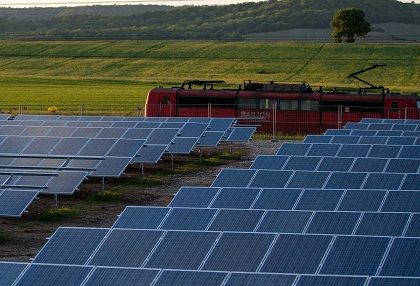
It was climate advocacy group 10:10 Climate Action and Imperial College London that got the ball rolling on powering UK railways with solar PV. Their campaign, named Riding Sunbeams, estimates that solar could power 20% of the Merseyrail network in Liverpool, as well as 15% of commuter routes in Kent, Sussex, and Wessex. Their website says:
“Direct solar supply of solar power to rail traction systems has never been done. But it has huge potential - from metros, trams, and railways in the UK and around the world. After extensive feasibility work and research, we’re almost ready to connect the first pilot solar panels to the railway.”
The Department of Transport in the United Kingdom, who backed the project, is keenly awaiting the results of the project’s results - they hope that the straight-solar process could be rolled out to other train stations around the country. They also hope this technology might extend to the tube and tram networks as well.
The directors of Riding Sunbeams say that technology could also transform railway industries in countries that rely heavily on trains. The Guardian reports that India ‘already has 250 trains powered by solar panels attached directly to the roof of the train, but it plans to develop its own trackside solar farms’.
The move would also open up employment opportunities for electrical engineers in the UK who can assist with rolling out the solar arrays for all train stations across the nation. Leo Murray, the director of the Riding Sunbeams project told media:
“Matchmaking the UK’s biggest electricity user, the railways, with the nation’s favorite energy source, solar power, looks like the start of the perfect relationship.”
“Helping to get the railways off fossil fuels in this way will cut running costs and benefit local communities at the same time as helping to tackle the climate crisis.”
Works Cited
Ambrose, Jillian. “Rail Line in Hampshire Is World's First to Be Powered by Solar Farm.” The Guardian, Guardian News and Media, 23 Aug. 2019, www.theguardian.com/business/2019/aug/22/rail-line-in-hampshire-is-worlds-first-to-be-powered-by-solar-farm.
Griffin, Esther. “Taking Solar Railways off the Drawing Board onto the Tracks - 10:10 Climate Action.” 10, 10:10 Climate Action, 8 Mar. 2019, 1010uk.org/articles/taking-solar-railways-off-the-drawing-board-onto-the-tracks.
- Details
- Written by: Quintus Potgieter
In 2016, France announced an exciting plan that would hopefully power 5 million homes with electricity. The plan entailed paving over 1000 kilometers of road with photovoltaic panels, generating around 790kWh every day. However, what was supposed to the first step of a revolutionary development ended up being a bitter disappointment.
One kilometer and eight million dollars later, the issues of the road were already piling up.
The solar panels suffered immense wear and tear, to the point where some were completely shattered from the pressure of traveling cars. Some sections also failed to work to their full potential when moving dirt had covered the panels. Their horizontal position on the road also meant they were not directly facing the sun for many hours of the day, adding up to be incredibly inefficient.
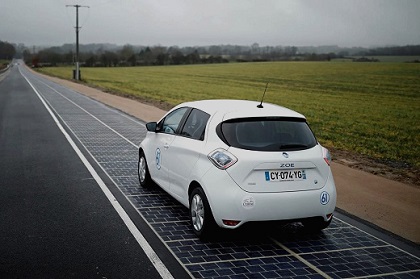
The road also generated a strange noise, which forced traffic officials to change the speed limit of the paneled road to 70 kilometers per hour.
Now that the experiment is over, the government’s idea of rolling out 1,000 kilometers of the solar road has ground to a sudden halt. With all of the issues that have dogged the road, the electricity output of the solar road has been abysmal.
Alain Pelleray, a senior regional officer in the department of Orne in Normandy told media:
“As time went on, we realized that on an economic and financial level, in terms of producing electricity, it was a failure.”
The initial projection was that the roadside solar panels would, from December 2016 to March 2019, generate 624MWh (megawatt hours) but it the final results didn’t even make it halfway with the road only generating 229MWh. The plan was to sell the electricity to state-owned power company EDF with an expected 35,000 dollar profit –however, they only sold 13,000 dollars.
Nonetheless, Pelleray says much has been learned from the project and they are looking forward to continuing the experimentation with solar roads. Pelleray said:
“We have no regrets, the department did not spend anything on this and we are talking about applied research. In terms of renown, we hit the jackpot. We’ve had visits by Korean and Chinese tourists and industrialists.”
It is also back to the drawing board for the manufacturer of the panels, Colas, to solve the complications associated with the panels themselves. Colas Group’s Wattway panels were tipped to be the most promising solar roadway technology manufacturers, and they now have to rethink the entirety of their panel engineering. Colas is reportedly working on hundreds of small solar experiments to in an effort to determine how to capture the most sun as possible.
In another part of the world, Chinese industrialists are witnessing their own problems with solar roadways. In 2018, China opened a ‘solar highway’ in Jinan which was said to be longest solar roadway in the world at the time of its opening.
The first issue was vandals stealing portions of the road, and the second was passing vehicles causing layers of damage to the road. The Chinese used a glass-based photovoltaic panel (covered with a layer of concrete) that splintered when heavy items fell from trucks onto the highway. The fractures in the panels got worse when passing vehicles dragged bits of glass down the highway.
The hurdles the solar roads have faced now represent an opportunity for engineers. Engineers can now apply what they have learned and look for ways to strengthen the photovoltaic solar panels.
Works Cited
“China's 'Solar Highway' Was a Victim of Bad Design, Not Thieves.” South China Morning Post, 16 Apr. 2018, www.scmp.com/news/china/society/article/2131241/chinas-solar-highway-was-victim-heavy-traffic-and-bad-design-not.
Jakarta Post. “France to Try Again with Solar Road Plan.” The Jakarta Post, www.thejakartapost.com/life/2019/07/25/france-to-try-again-with-solar-road-plan.html.
- Details
- Written by: Isabella Foster
The Netherlands is a country well known for its intricate landscape of canals, tulip fields, windmills and cycling routes. But did you know that the country has been in a defiant war against water since the early 17th century?
The Netherlands relationship with water is complicated, to say the least. Nearly a quarter of the country lies below sea level and another half sits less than a metre above, putting the country’s entire existence under constant attack from the elements. Consequently, the country has fallen victim to a number of serious floods over time.

A defining landmark in the country’s history in the North Sea flood of 1953. After a heavy storm on the night of 31 January 1953, citizens of the Netherlands woke up to large areas of the country completely underwater. The devastating floods claimed 1,835 lives and forced the emergency evacuation of over 70,000 more. The total damage from the floods was estimated to be over 800 million dollars.
The catastrophic flooding led to multiple in-depth government reviews of events and how they could be prevented, ultimately leading to the developed water defences the Netherlands possesses today. The country’s highly symbolic systems of windmills, canals, ditches, dikes, dams and dunes aren’t just for Instagram aesthetics or utility, but actually a fully-functioning security strategy against mother nature.
One of the largest physical defences the country uses against rising water levels is a device called the Maeslantkering. This enormous piece of machinery is effectively a set of doors that blocks off the ocean when sea levels rise too high. Would you believe that this contraption is almost as long as the Eiffel Tower if it was laying on its side?
Acting as the final piece of the Delta Works, a construction program started by the Dutch government after the catastrophic floods of 1953, the Maeslantkering automatically closes when threatened by floodwaters. It is one of the largest moving structures on Earth, rivalling the Green Bank Telescope in the United States and the Bagger 288 excavator in Germany.
Whilst it sounds bleak, the pressure of the situation has put Dutch engineers at the top of their game. It’s no surprise that they are world leaders in flood protection, storm surge barriers and other water management technologies that are constantly emulated around the world.
As the risk of climate change continues to increase and sea levels rise, the Netherlands future is increasingly uncertain however engineers are constantly working hard towards engineering innovative solutions such as parking garages that can serve as emergency reservoirs.
The Netherlands’ flood defence network is robust and broadly supported. More than 300 institutions, organizations and boards work together to devise comprehensive plans, continually assessing their effectiveness and keeping residents informed of their progress.
Works Cited
Hall, Alexander. “The North Sea Flood of 1953.” Environment & Society Portal, Arcadia (2013), no. 5. Rachel Carson Center for Environment and Society. https://doi.org/10.5282/rcc/5181
